EASY TO PREPARE & EASY TO LOVE




IMPROVED NO.797 AUGUST 2023




Serving suggestion *Product needs to be decanted into a separate container before microwaving #Bain-marie stable – held covered for no more than 4 hours IMPROVED Now it’s easier than ever, to add delicious MAGGI ® Ready to use Gravy, to your customer’s favourite dishes. All you have to do is decant, heat and serve. EASY TO PREPARE & EASY TO LOVE 1L Squeeze Bottle Made in Australia Microwaveable* Bain-marie stable# Simply decant, heat and serve Gluten free endorsed by Coeliac Australia and NZ Visit www.nestleprofessional.com.au/maggi/maggi-professional-gravy-ready-use to find out more or contact your local Nestlé Professional Sales Representative on 1800 20 30 50



NO.797 AUGUST 2023 LONGSHORE • RED WINE COCKTAILS • PUBLIC HOSPITALITY’S NICK MAHLOOK • TOASTIES
16 CONTENTS // August
Contents
AUGUST 2023
Regulars
8 // IN FOCUS
Behind the scenes of modern-day catering and events business Aplenty.

12 // NEWS
The latest openings, books, events, and more.
14 // PRODUCE
Everything you need to know about the snake bean.
16 // BAR CART
Thirst quenchers, slow sippers, and all things beverage related.

18 // DRINKS
Four drinks specialists share how they use red wine in cocktails.
22 // PROFILE
Chef Jarrod Walsh on opening seafoodcentric fine diner Longshore.
44 // EQUIPMENT
The gastronorm tray is small but mighty.
Features
26 // THE NORTH AFRICAN COOKBOOK

Jeff Koehler’s deep dive into couscous.
30 // TOASTIES
Why the humble toastie is becoming the go-to option for small bars.
34 // MICE
What you can’t miss at the Melbourne International Coffee Expo.
38 // SUSTAINABLE PORK
Environmentally conscious practices at farms are making waves on the plate.
4 | Hospitality 26
46 // 5 MINUTES WITH … Nick Mahlook from Public Hospitality. 22
HOSPITALITY INDUSTRY BRIEFING
Powerhouse Parramatta is opening in 2025. We are looking for leaders in the Australian food industry to collaborate with us to redefine hospitality. Opportunities include retail food and beverage, catering, events and programs.
Tuesday 8 August 2023 Register here

FOOD
RETAIL
BEVERAGE CATERING EVENTS PROGRAMS RETAIL FOOD BEVERAGE CATERING EVENTS PROGRAMS
FOOD BEVERAGE
NEW ERA
Pizza is back on the menu at The Dolphin in Sydney. @hospitalitymagazine
 WE’RE IN THE final month of winter, and I have to admit, I am one of the few people who will miss it. The cool season has seen a stellar line up of launches from Longshore in Sydney (the subject of our profile) to the opening of Odd Culture’s first location in Melbourne. There’s much to look forward to as we move into spring with new steakhouse concept Alfie’s from Liquid & Larder arriving in the Harbour City soon, which is promising a steak on the table within 15 minutes of ordering. All in all, things are looking good. This issue, we delve into the world of North African cuisine, spend five minutes with
WE’RE IN THE final month of winter, and I have to admit, I am one of the few people who will miss it. The cool season has seen a stellar line up of launches from Longshore in Sydney (the subject of our profile) to the opening of Odd Culture’s first location in Melbourne. There’s much to look forward to as we move into spring with new steakhouse concept Alfie’s from Liquid & Larder arriving in the Harbour City soon, which is promising a steak on the table within 15 minutes of ordering. All in all, things are looking good. This issue, we delve into the world of North African cuisine, spend five minutes with
Public Hospitality’s Group Culinary Director Nick Mahlook, and speak to the force behind one of the most in-demand hybrid catering concepts Aplenty.
The August edition also looks at the importance of sustainability when it comes to working with Australian pork, the makings of a memorable toastie, and includes a roundup of what you can’t miss at the upcoming Melbourne International Coffee Expo.
Until next time, Annabelle
Cloros
Managing Editor
PUBLISHER Paul Wootton pwootton@intermedia.com.au
EDITOR
Annabelle Cloros
T: 02 8586 6226 acloros@intermedia.com.au
DEPUTY EDITOR Amy Northcott anorthcott@intermedia.com.au

DISCLAIMER
ADVERTISING NATIONAL Simon York
T: 02 8586 6163 F: 02 9660 4419 syork@intermedia.com.au
GROUP ART DIRECTOR –LIQUOR AND HOSPITALITY
Kea Thorburn kthorburn@intermedia.com.au
PRODUCTION MANAGER Jacqui Cooper jacqui@intermedia.com.au
CIRCULATIONS
To subscribe please call 1800 651 422. hospitalitymag azine.com.au facebook.com/ HospitalityMagazine twitter.com/Hospitalityed instagram.com/hospitalitymag
SUBSCRIPTION RATES
Australia:
SECOND LIFE
Gamberi
spaghetti at the revamped Lola’s in Bondi.

SNACK TIME
Party pies are levelled up with abalone at Longshore. @_amynorthcott
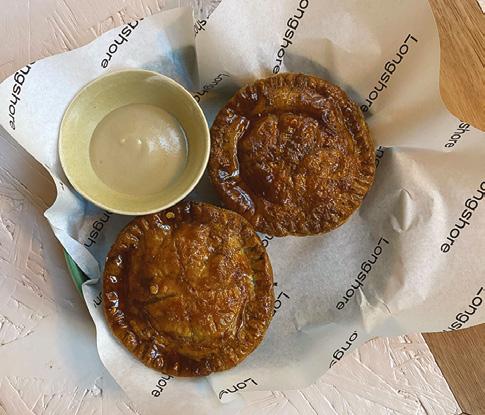
1 year (10 issues) = $99.00 (inc GST)
2 years (20 issues) = $158.40 (inc GST) – Save 20%
3 years (30 issues) = $207.90 (inc GST) – Save 30%
SUBSCRIPTION RATES
New Zealand:
1 year (10 issues) = $109.00
Asia/Pacific
1 year (10 issues) = $119.00
Rest of World:
This publication is published by Food and Beverage Media, a division of The Intermedia Group Pty Ltd (the “Publisher”). Materials in this publication have been created by a variety of different entities and, to the extent permitted by law, the Publisher accepts no liability for materials created by others. All materials should be considered protected by Australian and international intellectual property laws. Unless you are authorised by law or the copyright owner to do so, you may not copy any of the materials. The mention of a product or service, person or company in this publication does not indicate the Publisher’s endorsement. The views expressed in this publication do not necessarily represent the opinion of the Publisher, its agents, company officers or employees. Any use of the information contained in this publication is at the sole risk of the person using that information. The user should make independent enquiries as to the accuracy of the information before relying on that information. All express or implied terms, conditions, warranties, statements, assurances and representations in relation to the Publisher, its publications and its services are expressly excluded save for those conditions and warranties which must be implied under the laws of any State of Australia or the provisions of Division 2 of Part V of the Trade Practices Act 1974 and any statutory modification or re-enactment thereof. To the extent permitted by law, the Publisher will not be liable for any damages including special, exemplary, punitive or consequential damages (including but not limited to economic loss or loss of profit or revenue or loss of opportunity) or indirect loss or damage of any kind arising in contract, tort or otherwise, even if advised of the possibility of such loss of profits or damages. While we use our best endeavours to ensure accuracy of the materials we create, to the extent permitted by law, the Publisher excludes all liability for loss resulting from any inaccuracies or false or misleading statements that may appear in this publication. Copyright © 2023 – The Intermedia Group Pty Ltd
41 Bridge
Road Glebe NSW 2037
Net Distribution Period ending September 2019 – 11,506
6 | Hospitality
Follow us @hospitalitymagazine #hospitalitymagazine
up with the Hospitality team
Social
Keep
1 year (10 issues) = $129.00 Australia
Tel: 02 9660 2113 Fax: 02 9660 4419
EDITOR ’ S NOTE // Hello
Average
A note from the editor
@annabellecloros
11-14 September ICC Sydney
It's Unlocked Food
The ultimate B2B food event
It’s nearly that time of year again when the trade gathers under one roof at Fine Food Australia.
From retail, hospitality and bakery, to import, export, and distribution, it’s a world of active discovery for your business.
Fast-track your recipe for commercial success with the newest products and practical insights this September.
Unlock your senses at the ultimate B2B food event. finefoodaustralia.com.au


#FINEFOODAUSTRALIA Register Now
AUSTRALIA
PLATINUM SPONSOR PLATINUM SPONSOR
WHEN THE PANDEMIC hit London, Michaela Johansson jumped on her bike and began delivering picnic boxes to Hackney locals. She headed back home to Sydney in 2021 and launched the picnic boxes, which turned into what is now known as Aplenty, an events and catering concept. “I always wanted to run my own business and it felt like the right time,” says Johansson. “What started in my mum’s kitchen in Marrickville making picnic boxes for friends is now a much larger operation.”
Aplenty still offer the foundational picnic boxes, but the experience is now available on a larger scale, with the Aplenty team catering different events from small gatherings and corporate functions to large-scale weddings. The Aplenty experience is rooted in food and extends to event
Aplenty
WORDS Amy Northcott
production and styling — it’s immersive, to say the least.
Since launching the business, Aplenty has worked weddings at private properties as well as small-scale events at Sydney’s Paramount Recreation Club and Golden Age Cinema. The Aplenty offering features a range of set packages that include a combination of seasonal canapés, share plates, grazing and dessert tables, oyster bars, and live cooking stations. Johansson says she usually sticks to the set packages, but can make suggestions for clients who are indecisive or want to create a custom menu. Aplenty also works with public relations teams to curate branded offerings for clients and hosts quarterly tasting nights for clients to try bits and pieces.
When it comes to the style of food Aplenty creates, Johansson aims to offer something different and modern from traditional catering options. “I wanted to offer unique and contemporary experiences where food was a big part of the event, not just a requirement,” she explains. “[It’s] good food for good times with a focus on seasonality, punchy flavours, and surprising combinations.” Johansson describes Aplenty’s cuisine as share-style Mediterranean that’s fuss-free and delicious. She also works with local producers including Emilio’s Butchery in Rozelle, Vannella Cheese in Marrickville, and Holy Goat in Victoria.
Some of the dishes across the Aplenty offering include gildas, snapper crudo, and grilled octopus with ’ndjua
oil. Larger plates cover pork sausage ragu, grilled polenta with asiago, and cod kofta flatbread, with desserts spanning from dark chocolate and rum brownies to ricotta cannoli, and lemon and olive oil polenta cake. “Our goto for a wedding is grilled seafood canapés, seated share plates, and roving desserts,” says Johansson. “[We also] like bringing our charcoal grill to events and doing some live grilling to create a bit of atmosphere.”
The Aplenty offering is always growing and changing in line with Johansson’s love for culinary creativity. “I also wanted to create a workplace where my team of chefs and I can fulfill weird ideas or experiment to offer our customers something unique,” she says.

8 | Hospitality
Delivering picnic boxes on a bike turned into an events and catering business for Michaela Johansson.
IN FOCUS // Aplenty
But just when you thought that was enough to keep Johansson and her small team busy — think again. Earlier this year, Aplenty opened its own kitchen and events space in Redfern where dining experiences are held. Hosting events in a dedicated space has allowed the Aplenty team to be more experimental and creative in their culinary approach. “We have a bit more freedom to make what we want … maybe more spontaneous, experimental, or out of the ordinary of what we typically serve,” says Johansson. “It gives us a chance to play around with an idea and unleash it!”
Each dining session has a different theme and a sharestyle menu that is only revealed on the day of the event. “It’s all about the experience, so every single detail is thought of from the styling to the menu,
the way something is served, and the music playing,” says Johansson. “It feels so intimate and more special because of that.” It’s a communal-style set up, too, where guests come in groups, couples, or solo to mingle with others at the table.
Johansson has experienced the highs and lows that come with working in events and catering since launching Aplenty. Her advice to those looking to dabble in the space?


“Make sure you are as good at logistics as you are cooking — one does not work without the other,” she says. In the kitchen, the team has a joke motto: ‘perfect preparation prevents poor performance’. “It’s very American-military energy, but the biggest part of the job is preparation and planning.”
She also urges potential
catering and events gurus to focus on the details and find out as much as possible from customers and venues to avoid any problems on the day. Confidence, consistency, and sticking to your product offering is also essential. “You never know who is eating your food and where that will lead you,” says Johansson. “We have had some amazing opportunities come out of our events and catering orders. I
still have customers coming back from when I first started making picnic boxes.”
The rest of 2023 is set to be a busy one for Aplenty. Heading into the warmer months, most weekends are already filled with weddings. Alongside a busy schedule, Johansson is also growing the team and has hinted at a collaborative event in summer with a local Sydney artist — stay tuned. ■
August 2023 | 9 IN FOCUS // Aplenty
“I also wanted to create a workplace where my team of chefs and I can fulfill weird ideas or experiment to offer our customers something unique.”
–Michaela Johansson
Sitting ducks
Looking to add a new protein to your culinary offering? Here’s why it should be duck.
WHETHER YOU’RE THINKING of refreshing an existing dish or crafting a new one, duck is an easy way to elevate your menu. Duck’s versatility, low cost, and ability to work with multiple cuisines are just some of the many reasons why it’s a surefire way to take your food offering to the next level.
There is a range of new duck products now available on the market thanks to a free-trade agreement between Australia and Thailand. Until now, the availability of fresh, frozen, and cooked duck products has been restricted to domestic production, which can be costly and limiting. But now Australian hospitality venues can purchase high-quality cooked duck products for the first time from Thailand.
In line with the trade agreement, the world’s largest agro-industrial company CP Foods has launched high-quality duck products. Founded in 1921, CP Foods has dedicated itself to animal welfare, world-standard farming practices, and high-quality processing. The company can provide 100 per cent traceability with no requirement for third-party providers and has been awarded with the QS certification for poultry — the only company outside of the European Union to hold it. Here are some of the reasons why duck should be on your menu.
Versatility and easy application
Duck can substitute other meats such as chicken, beef, and pork, resulting in an unrivalled flavour profile on the plate. It’s a versatile protein that lends itself to an array of applications whether it’s on pizzas, in tacos, or the star of a Peking duck pancake.
Don’t have time to design new dishes? How about swapping out pulled pork on a pizza for some succulent shredded duck? Or what about creating a taco offering with duck as the leading protein? It’s also an effortless way to differentiate a salad with the option to add roasted duck breast.
Cost
Domestic duck production can be expensive and has previously seen a lot of operators dismiss the protein due to budgeting. Thailand is known for its high-quality duck meat and it is more affordable than domestic duck products, which enables operators to save. The CP Foods duck range offers great value, landing at $27 per kilogram or around $2.70 per 100g portion.
Time-saving preparation
The CP Foods duck range is cooked and fully frozen for your convenience. With its quick and easy preparation, it’ll save time in the kitchen and be on the plate in no time. There’s an array of portion sizes to suit any venue, too. Take your pick from half or whole ducks along with different shredded meat packs.
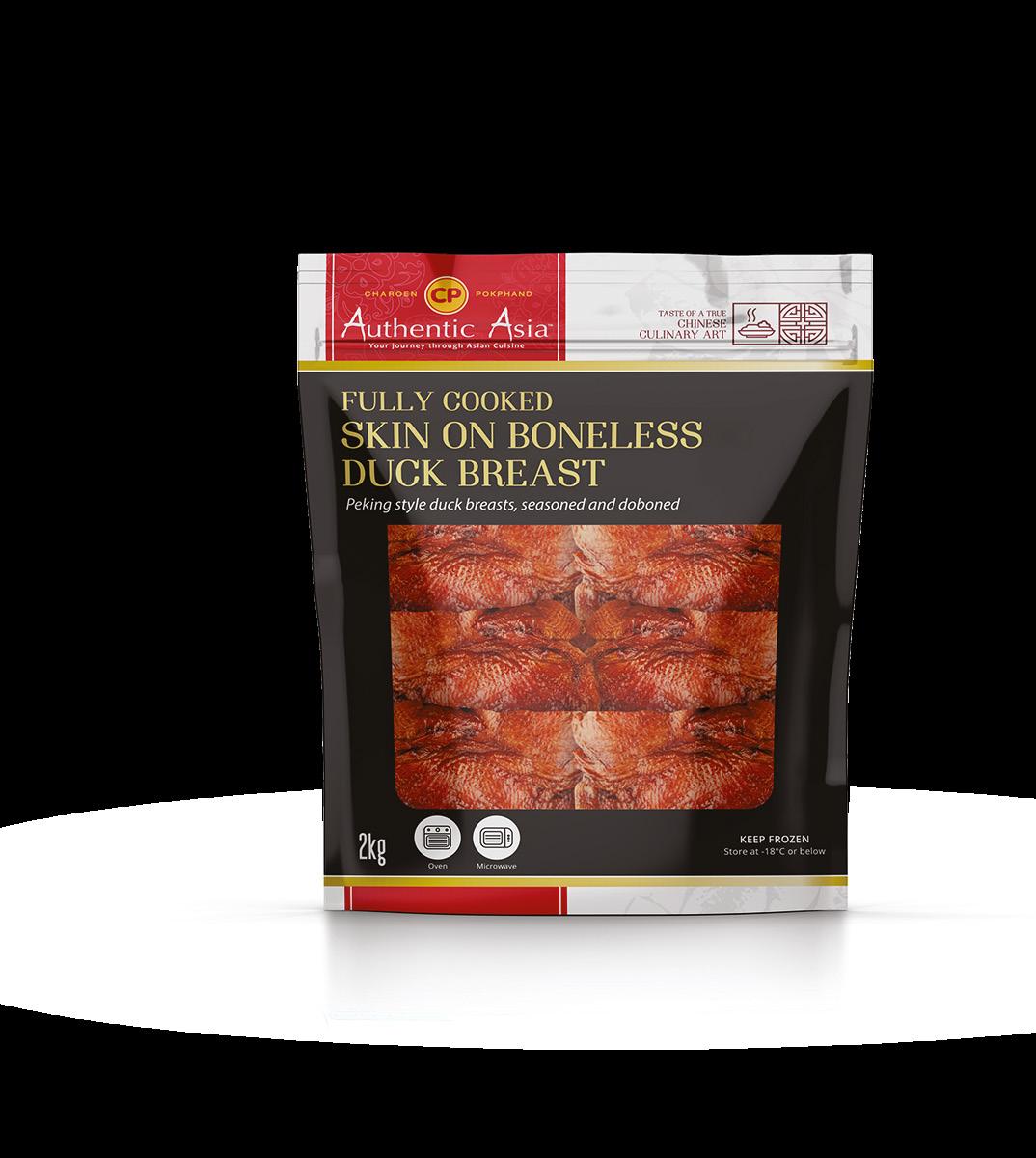
Variety of protein styles
The CP Foods duck range ensures there’s plenty of ways for duck to be used on the menu. The range features everything from shredded, roasted, boneless, and Peking duck options.
The CP Foods duck range includes:
Aromatic shredded roast duck: An ideal option to elevate your taco offering or a

great addition to salads, soups, noodle dishes, and pizzas.
Boneless duck breast: Stands its ground in flavour when served by itself or can be added to any dish as a substitute for beef, chicken, or pork.
Boneless Peking fried duck: Suits traditional Peking-style pancakes and can be used in salads, stir fries, banh mi, and tacos.
Roasted aromatic shredded duck: An easy and flavoursome addition to pizzas, soups, salad, or sushi.
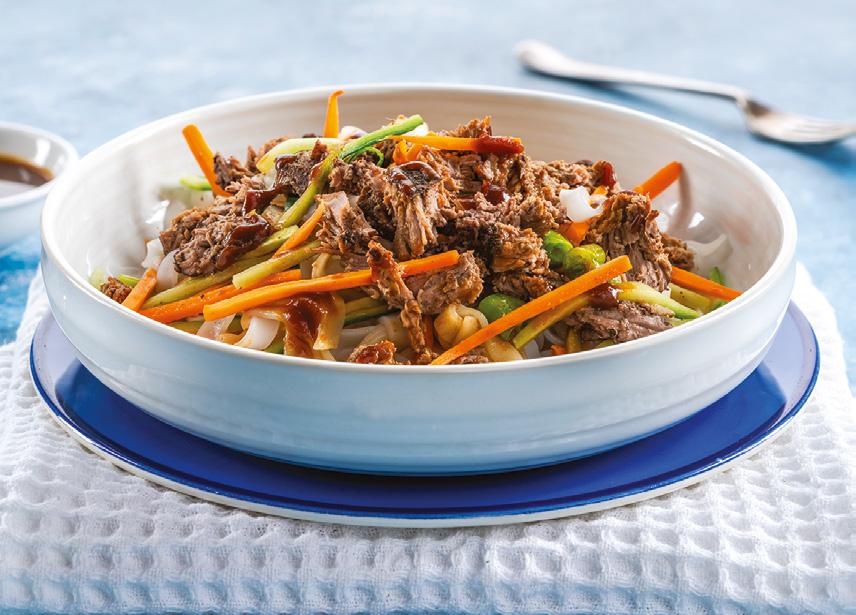
Duck can add a new edge to your culinary offering and is sure to spark interest with consumers. With its low cost, ease of application, and versatility, CP Foods’ high-quality, flavoursome duck is sure to work in the kitchen and on the plate.
To find out more about the CP Foods duck range, visit cpfglobalsourcing.com/duck ■
ADVERTORIAL // CP Foods










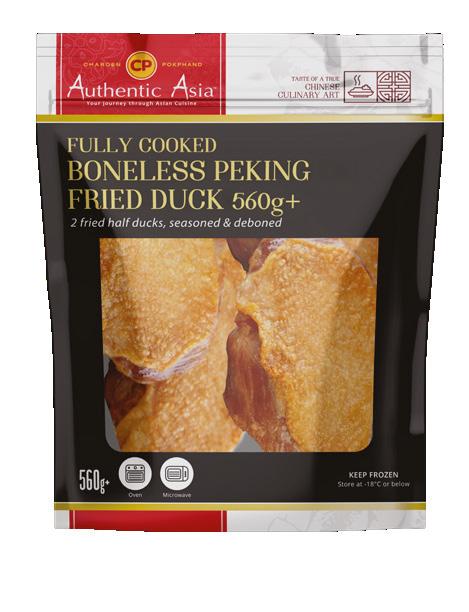


Entrée
The latest openings, books, events, and more.
EDITED BY Annabelle Cloros
Bao
 By Erchen Chang, Shing Tat Chung, and Wai Ting Chung Phaidon ; $59.95
By Erchen Chang, Shing Tat Chung, and Wai Ting Chung Phaidon ; $59.95
London eatery Bao is renowned for its signature take on Taiwanese cuisine, and the first book from the trio behind the venue certainly delivers. Bao features 100 recipes from the founders spanning steamed buns and fried chicken to beef noodles, xiao chi, milk foam tea, and much more. The recipes are accompanied by both illustrations and photography and is described as ‘part cookbook, part manifesto’. phaidon.com
Pasta by moonlight
Sydney institution Icebergs Dining Room and Bar continues its 20th-year celebrations with the Full Moon x Festa Della Cucina Italiana series. Each menu is made up of Italian street food dishes from regions across Italy such as crostone al prosciutto e scamorza and a pork collar and horseradish panini. Meals will be paired with wine and small drinks, with upcoming evenings showcasing culinary delights from Friuli (2 August) and Lazio (28 September). Diners will watch the full moon rise above the Pacific Ocean and enjoy a dining experience with sounds courtesy of DJ Dolso. idrb.com

Photography by Nikki To
From tree to kitchen
Award-winning producer Cobram Estate has introduced a subscriptions model to make buying Australian olive oil more affordable. There are two categories of subscriptions available under the banners of essential varieties and ultrapremium, with each containing three 600ml pouches of extra-virgin olive oil along with a reusable ceramic bottle in the first order. Deliveries are made every two, four, or six months and come with a return envelope for customers to send back the pouches to be recycled. cobramestate.com.au

12 | Hospitality NEWS // Entrée
Neighbourhood nights
Local wines on tap? A $39 banquet from a former Ottolenghi chef? Waygood in Melbourne’s Richmond is the venue you’ll find both at, with the wine bar recently welcoming Brad Cunningham as its new head chef. Each week will see a different menu go live, with dishes including green falafel with yoghurt and coriander flatbread and whole-roasted cauliflower with burnt honey and preserved lemon. Proteins such as lamb shoulder with baharat, golden raisins, olives, and capers can also be added on. Wines by the glass start at $10 and carafes are no more than $35. waygood.com.au
High steaks
Liquid & Larder is known as the force behind the iconic Sydney restaurant Bistecca, and now the group will launch something a little different — Alfie’s — a pocket-friendly steakhouse. “We’re flipping the steakhouse model on its head and it’s going to be really fun,” says Co-Founder James Bradey. The Bligh Street restaurant is slated to open in September and will offer cuts including sirloin from the Riverine region as well as T-bone and ribeye that will arrive at the table within 15 minutes. The venue will also have a dedicated bar area led by Alex Gondzioulis and a central butchery and steak-ageing space that will supply the group’s other restaurants. alfiessydney.com.au


Henrietta arrives in Melbourne
Esca Group has made its first foray into Melbourne with Sydney charcoal chicken concept Henrietta. The Windsor iteration of Henrietta is serving much more than just chicken, with the menu listing Middle Eastern-inspired dishes — think kingfish with baharat and rhubarb; falafel with tahini and house pickles; carob-glazed lamb shoulder with mujadara and smoked labneh; and duck koftas with lettuce and cacik. “This new Henrietta is a little different … and leans more into the refined palates of Melbourne’s elaborate food scene,” says Co-Founder Ibrahim Moubadder.
“We found there was a lack of charcoal chicken, and we wanted to share the love, but this time in a more elevated way.” henriettachicken.com
 Photography by Jiwon Kim
Photography by Jiwon Kim
August 2023 | 13 NEWS // Entrée
Photography by Kristoffer Paulsen
Vines
Snake bean
The long, slender vegetable is a common feature in stir fries and curry dishes.
WORDS Amy Northcott
Thrives in warm and humid climates with regular rainfall
Also known as the yardlong bean or asparagus bean
Grown across the Northern Territory and in Queensland
Well-suited to stir fries and curries
Origins
The snake bean, also known as the yardlong bean or the asparagus bean, is part of the legume and pea family of flowering plants known as Fabaceae. Snake beans come from the subspecies Sesquipedalis which translates to ‘1.5 feet’ in reference to the size the bean pods can reach. It is believed the vegetable originated in Southern China or Africa before it spread across South-East Asia and beyond. It is now a popular ingredient in India, the Philippines, China, Malaysia, Taiwan, Thailand, and the Caribbean. The snake bean is grown here in Australia across the Northern Territory and in Queensland.
Growth and harvest
Tropical and subtropical climates with humidity and regular rain are best for snake
beans — they should not be planted in areas prone to frost. It’s best to grow snake beans during the warmer months, however the annual plant can be grown at any time of the year.
Snake bean plants are climbers, and it is recommended they are planted alongside a tall trellis, fence, or shrub. Snake bean seeds should be planted about 1cm deep in slightly damp, warm soil about 30cm apart. It is important not to water the seeds until they germinate to avoid rotting, which typically occurs three to five days after sowing. Seedlings should appear between 10 and 21 days after planting and the beans can be harvested eight to 10 weeks after sowing.
The beans are ready to be picked when the outline of the seeds are visible from the outside of the pod. Pods should always
Popular vegetable in South-East Asia and India
Has a nutty flavour similar to asparagus
Can be sautéed, blanched, or eaten raw
be picked before they harden and swell. Snake beans are white–green in colour, have brown seeds inside, and can reach 30–120cm in length.
Flavour profile and culinary uses
Snake beans are longer and lighter in colour than regular beans but can be used in similar applications. They have a crunchy texture with a nutty flavour akin to asparagus. Snake beans are commonly used in stir fries and curries to add texture, and are also a popular addition to omelettes and salads. In Cantonese cuisine, snake beans are staples in classic stir fry dishes with minced proteins alongside garlic, hoisin sauce, soy sauce, and fish sauce. In India, snake beans are called phali or chavali and are used in curries, fried rice, stews, sabzi (a vegetable dish), and rice pilaf. ■
14 | Hospitality PRODUCE // Snake bean
can grow up to 2 metres high
You’re invited
THE NSW GOVERNMENT’S new Sydney Fish Market project has announced a range of tenancies are now available for lease – and they want you. After undergoing extensive renovations, the iconic Sydney seafood hub is ushering in a new chapter for its iconic site, and now is the chance for your hospitality business to be a part of it.
Set to open in 2024, there are 19 opportunities available to food and beverage businesses across the 30,000 sqm site that come in a range of sizes to suit any hospitality offering, with small, large, and grab-and-go style spaces available. The site’s restaurants, bars, and hospitality offerings will trade seven days a week to ensure the Sydney Fish Market is a place for everyone to visit no matter what they are in search of.
Retail Strategy Group has been appointed to develop the Sydney Fish Market’s strategy and leasing. Founder and Director Angela Bonnefin says it is a once-in-a-lifetime opportunity to be a founding partner for the site. “We want the finest operators in each category to join us on a journey to create a world-class fresh food marketplace,” she says. “Everyone is eligible to apply through the expressions-of-interest phase and we can’t wait to work with retailers to bring this iconic project to life.”

The Sydney Fish Market is the largest working fish market in the Southern Hemisphere and has been designed by architects 3XN. The new design combines modern architecture with the spirit of the seafood industry through elements including a wave-shaped, scalepatterned roof.

Located less than 2km away from the CBD and with a backdrop of the stunning Blackwattle Bay, the site is set to embrace its surrounds. “It is not a generic construct that can be built anywhere,” says Architect and Partner at 3XN Fred Holt. “Instead, it is designed

to accentuate its location and allow the promenade to move through the building, providing captivating vistas of both the waterfront and the park.”
Holt also says the design focuses on fostering a sense of connection with Sydneysiders. “The revitalised market acts as a social catalyst for community activity and will establish itself as an exciting new destination in Sydney,” he says. “Additionally, it rekindles a sense of nostalgia among Sydneysiders, as it brings them back to the beloved and iconic Fish Market.”
The NSW Government has invested $750 million into the site, with the purpose-built facility set to be an outstanding showcase of Sydney’s seafood industry. CEO of Sydney Fish Market Greg Dyer says the revitalised site will also go even further to offer so much more to visitors. “Sydney Fish Market is already so much more than a fish market – we are a one-stop-shop for Sydney food lovers with a fantastic butcher, bakery, green grocer, artisanal deli, and a bottleshop on site, as well as our world-class wet seafood retailers,” he says. “Our new state-of-the-art facilities present an opportunity to expand the Market’s offerings even further and deliver a truly oneof-a-kind visitor experience.”
The renovated Sydney Fish Market is expected to the double visitation numbers of the previous site, with around 6 million people set to walk through the doors each year.


Expressions of interest to be a part of Sydney Fish Market’s next chapter are now open to all hospitality businesses. Submissions are through Retail Strategy Group’s Angela Bonnefin and have a deadline of 31 August 2023.
For enquiries, and to submit expressions of interest, contact Angela Bonnefin: angela@retail-strategy.com; 0418 257 143 ■
August 2023 | 15 ADVERTORIAL //
Sydney Fish Market
The new Sydney Fish Market is on the hunt for hospitality and retail businesses.
Bar cart
Thirst quenchers, slow sippers, and all things beverage related.
 EDITED BY Annabelle Cloros
EDITED BY Annabelle Cloros
Up, up, and away
Four Pillars has launched a boosted ABV gin that’s only available at Heinemann locations. The 50.8 per cent ABV Rare dry gin is 9 per cent higher than the original version but features the same freshness from organic oranges and complex juniper foundation. “We haven’t changed this recipe since we first released it in December 2013, so to revisit it nearly 10 years on is a significant moment,” says Co-Founder and Distiller Cam Mackenzie. The gin is $79 for 1 litre and can be purchased at domestic and international stores in Sydney Airport and the wider Heinemann network in the coming months. fourpillarsgin.com

Shiraz for a cause
Yalumba has launched the second wine in its Homefullness series, which has seen the winery raise muchneeded funds for the homeless community. Senior Winemaker
Sam Wigan says the wine has flavours of berry cheesecake, cinnamon, and dark chocolate: “it’s as lush as Barossa Shiraz gets”. The Barossa Shiraz 2021 has a $90,000 target, which sees proceeds go towards building ‘pods’ for people to live in. $22 per bottle or $240 for a dozen. yalumba.com


Homegrown
Dan Leuzzi and Tom Giurioli from Freddy’s Pizza are the two minds behind Tommy’s Booze, an Italiancentric liqueur concept based in Melbourne. Giurioli’s nonna’s limoncello recipe has been bottled up and uses hand-peeled imperfect lemons sourced from Victoria and Queensland. The range also includes Mandarino (mandarin) and Lampone (raspberry) liqueurs, with each option available in 700ml bottles priced at $66 a pop. tommysbooze.com.au
Instant martini
First came the Negroni, and now another classic: the martini. Versa has released its own take on the essential cocktail, combining London dry gin and dry vermouth in a 700ml format ($75). Each bottle makes nine martinis and is best kept in the fridge — simply shake with ice, strain, and serve in a glass of your choice with a lemon twist or a spear of olives. versacocktails.com.au

Fusion drop
It’s that time of year again — Grenache gin time, but the 2023 iteration looks a little different. Never Never Distilling Co. has used locally grown grapes from the McLaren Vale region and combined the fruit with gin, leaving the mixture to sit on skins for an extended period which has resulted in a drink with notes of vanilla custard, buttered crumpets, and freshly picked blackberries. Kerri Wright has designed the artwork for the 2023 Ginache ($85 for 500ml), which was inspired by Dionysus. neverneverdistillingco.com.au
16 | Hospitality NEWS // Drinks

https://hoshizaki.com.au/product-category/ice-machines/km-kmd-crescent/ COMMERCIAL ICE MAKERS | REFRIGERATION hoshizaki.com.au Crescent icemakers THE UNIQUE PURITY WITH AN EDGE Scan the QR Code for the full range



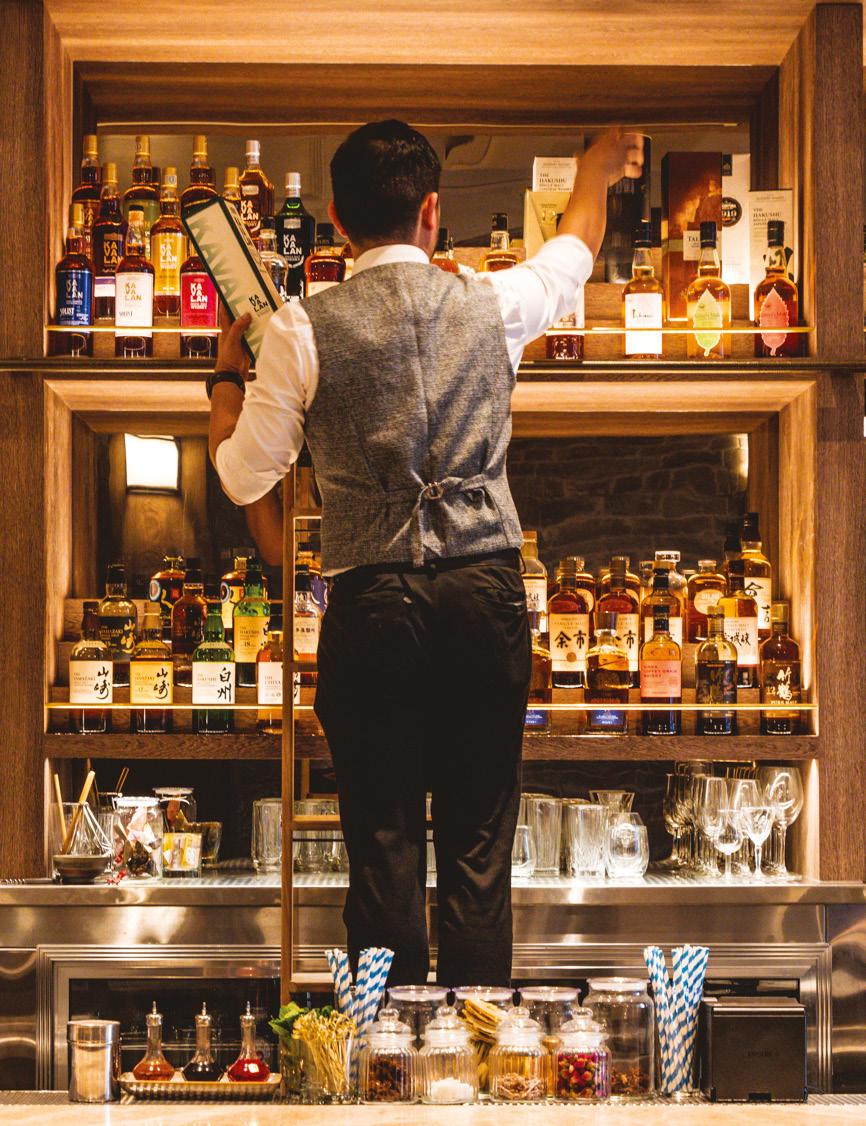
18 | Hospitality
Seeing red
Move over sangria, there’s a new line up of cocktails putting red wine in the spotlight.
WORDS Amy Northcott
PHOTOGRAPHY Gareth Sobey for Bar Margaux
WHEN YOU THINK of cocktails made with red wine, drinks such as sangria and kalimotxo may come to mind. But red wine is a more versatile cocktail addition than most would think. It lends itself to spritz-style creations along with richer, higher-ABV options.
Hospitality speaks to Yoshi Onishi from Banchō Bar, Darcy Travers from Strange Company, Nat Yao from Bar Margaux, and Brock Upton-Steele from Death & Taxes to find out how bars across Australia are using red wine in their cocktails.
Hong Kong Sour
The Hong Kong Sour takes its cues from the New York Sour and has been a popular cocktail at Banchō Bar since it opened in Sydney’s Chinatown. According to Group Beverage Manager Yoshi Onishi, Banchō’s version ties in with the venue’s Asian-inspired backstory. “It’s a red wine float infused with whole spices from Chinese five spice mix and a hint of Sichuan peppercorns,” he says. “The spices bring a unique richness to the cocktail, complementing the spiciness of the rye whiskey.”
Red wine is a key ingredient in the classic New York Sour, and Onishi uses it in Banchō’s version, but in a reduced form. The wine is mixed with cinnamon quills, fennel seeds, coriander seeds, cloves, and star anise over heat and reduced to 75 per cent before it’s strained. “We reduce the red wine to integrate and enhance the spice notes,” says Onishi. “We need it to produce enough flavour and aroma as we only need a small amount in the cocktail.” To make the Hong Kong Sour, rye whiskey, lemon juice, and sugar syrup are shaken and strained before the red wine reduction is poured on top, creating an eye-catching contrast in colour between the two layers.
Onishi admits red wine is not the most common ingredient found in cocktails, which means it does spark interest among drinkers. “Red wine can bring complexity to a cocktail without adding a lot of extra alcohol into it,” he
says. “It can easily be used as the base ingredient of your cocktail … or can even be turned into an ice cube to serve with your whiskey sour.”
The Bowline Fizz
At Fremantle’s Strange Company in Perth, the Bowline Fizz is one of the latest cocktails to be added to the menu. Crafted by Venue Manager Alex Handley, the cocktail features an element made of red wine and watermelon sorbet. Co-Owner Darcy Travers says the cocktail was inspired by the sgroppino along with the team wanting to make a red wine sorbet. “Visually, it is a colourful drink with a huge amount of texture and fun coming from the red wine sorbet playing off the sparkling wine,” says Travers. The Bowline Fizz is made from Plantation 3 Stars white rum, apple syrup, and lime juice shaken with ice. A scoop of sorbet is added to the glass before the rum mixture is strained over it and topped with sparkling wine. “It introduces itself with a burst of dry bubbles and the malic acid of the apples before the white rum shines in the middle, giving body to the drink. The red wine and watermelon sorbet leaves you with a sweet, tart, and distinct red wine flavour that is not overpowering or unbalanced.” The Bowline Fizz works well in place of most aperitifs and is ideal for pairing with snack-style dishes, cheese, and charcuterie boards.
It’s not the first time Strange Company has opted to add a red wine-based cocktail to its menu, with the Summer Del 66 a popular choice
Bancho Bar’s Hong Kong
Sour is a riff on the New York Sour
Strange Company was inspired by the sgroppino for the Bowline Fizz cocktail
Bishop is Bar
Margaux’s first red winebased cocktail
Death & Taxes use Shiraz for its texture, body, and tannins
August 2023 | 19 DRINKS // Red wine cocktails
“Cabernet Sauvignon is more likely to stand up against heavy whiskey, but might be too overpowering for a nuanced gin where you may have more luck with a light Grenache or a Pinot Noir.” – Darcy Travers
during the warmer months. “It [red wine] can bring a whole range of flavours from bright red fruits, black fruits, and blue fruits through to chocolate, menthol, and spices,” says Travers. But bartenders are encouraged to carefully consider which style of red wine to use in cocktails as a one-size-fits-all approach doesn’t apply. “Cabernet Sauvignon is more likely to stand up against heavy whiskey but might be too overpowering for a nuanced gin which may have more luck with a light Grenache or a Pinot Noir.”
The Bishop
Melbourne’s Bar Margaux is beating the winter chill with its take on the classic Bishop cocktail. Venue Manager Nat Yao and her team have changed the classic recipe by opting for rum instead of port to give the drink a softer character. For the red wine addition, they reach for Merlot. “The wine gives a delightful, warming punch and a spiced richness on the palate when used alongside Jamaican rum,” she says. “It imparts a nuanced intensity of plum and dark berry aromas.”

Orange bitters, lime juice, simple syrup, Merlot, and Jamaican rum are combined in a heat-proof vessel, which is warmed using a coffee steamer or simmered on the stove before being poured
into a warm mug and served with a lime wedge. “The drink is reminiscent of a Toddy with gentle tones of a mulled wine … the Bishop cocktail is entrancingly deep while whimsically sharp,” says the bartender. The Bishop is designed to enjoy as a nightcap, and suitably pairs with the venue’s crème brûlée or a cheese platter.

While the Bishop is Bar Margaux’s first red wine-based cocktail to make the drinks list, Yao says the bar team never turns down an opportunity to create a New York Sour. Her advice for using red wine in cocktails? Keep the good stuff in the cellar. “No need for a fancy bottle, if there’s a spare dreg around, get experimenting,” she says. “Red wine pairs well with citrus for a summery beverage, and little touches are also great for spirit-forward cocktails as it can add structure and dimension.”
The Voltaire
Brisbane bar Death & Taxes is pouring its take on the classic Manhattan with none other than Shiraz. Venue Manager Brock Upton-Steele says the Voltaire cocktail is a “seductive twist” on the Manhattan and has a flavour profile based on orchard fruits. “Voltaire is a stiff Scotch drink with a textural component taken from the tannic nature of Shiraz,” he explains. “The flavours give way to brighter fruits such as cherry and plum before finishing with a malty sweetness.”
The Voltaire is made with Monkey Shoulder, Muyu Vetiver Gris, cherry syrup, and Shiraz which is stirred down until chilled and served in a frozen martini glass. “Shiraz brings a texturally tannic element to the cocktail which allows a subtle bitterness and balances the sweeter flavours,” he says. “Being a heavier-bodied red, [Shiraz] provides a wide mouthfeel to the drink juxtaposed with the sweetness of cherry.”
Red wine is also teamed with whisky in a New York Sour at the bar, with its complexity giving drinkers something to think about. “It brings a lot of different characteristics to cocktails and acts as a great balancing agent,” says Upton-Steele. “A slightly oxidised and acidic red can balance sweeter flavours while bringing a textural element.”
Next time your drinks list is in need of a refresh, experiment with a bottle of red and create a drink that’s sure to be a unique addition to the menu, bringing body and balance to the table. ■
20 | Hospitality DRINKS // Red wine cocktails
“Red wine pairs well with citrus for a summery beverage, and little touches are also great for spirit-forward cocktails as it can add structure and dimension.”
– Nat Yao


IntroducingNEW Cooking Cream Serving suggestion For more information, visit www.begafoodservice.com.au or contact customer sales on 1800 000 570 Heats quickly to high temperatures, without burning or splitting Full cream taste profile, with fresh aroma and silky mouthfeel Ideal viscosity for sauteing, reducing, pan-frying, baking, freezing and whipping 18% fat Proudly Australian owned and made
Longshore


22 | Hospitality
Chef Jarrod Walsh is riding a new wave of dining at his dream restaurant.
WORDS Annabelle Cloros
PROFILE // Longshore
PHOTOGRAPHY Jason Loucas
JARROD WALSH and Dot Lee are no strangers to taking over a familiar space. The pair guided Hartsyard into its second chapter, running the Newtown eatery in Sydney for four years until an opportunity to become the custodians of the former Automata location presented itself. It was a fortuitous moment — especially for Walsh, who once worked in the kitchen of the fine diner. “I loved the space and the fit out,” he says, “but I was like, ‘I can’t have an attachment to it — it needs to be your own thing’.” And that’s how Longshore came to be.
Walsh speaks to Hospitality about building a restaurant from scratch for the first time, lessons learned from running Hartsyard as a business owner, and rolling with an ‘anything goes if it tastes good’ mentality in the kitchen.
Timing is everything — especially in restaurants. And while there never seems to be enough time in a day, milestone moments come about regardless — spearheading your first restaurant is one of them. Longshore is the culmination of many years spent in the kitchen and on the floor for chefs Jarrod Walsh and Dot Lee, who opened the doors to their Chippendale restaurant in June this year. “It took a lot of time to build up to this,” says Walsh.

Walsh and Lee took over Hartsyard from previous owners Gregory Llewellyn and Naomi Hart in 2018, with the first-time restaurateurs coming to realise they were ready for something new. “Hartsyard was our playground in doing what we loved and not having many restrictions, but after a few years, we wanted more,” says Walsh. “The opportunity came up at The Old Clare Hotel to set up the hotel side of things and ultimately take over the restaurant space.”
Opening a restaurant in Automata’s place generated excitement, nerves, and of course, a fear of the unknown, but Walsh and Lee were more than ready, having been through a comparable experience at Hartsyard. “We made mistakes, and we worked out what not to do,” he says. “We knew how to take over a restaurant
that’s iconic and not make those mistakes again, which is what we’ve done at Longshore. You don’t want people to compare and say, ‘Automata used to be like this or do that’, — we’re the opposite of what it was.”
There’s no replicating a restaurant like Automata, and there was no question Longshore would be an original concept with an original fit out. Nevertheless, the redesign process began with a wave of nostalgia. “It hurt me to say, ‘We need to get rid of all this stuff’, but it was so essential,” says Walsh. “We’ve gone for a warmer interior compared to the minimalist approach Automata had. We went with recycled timber tables and all our coasters are made from recycled plastics, which ties in with the minimal-waste approach we take with our menu and cocktails.”
It’s difficult to define the culinary backbone of Longshore — an intentional move by Walsh who developed the concept while winding down at Hartsyard — something that was only possible with the support of the people around him. “We built a good team from the start at Longshore and we could put our trust in them,” says the chef.

Walsh knew Longshore would be a seafood-centric eatery, having grown up fishing and cooking with seafood throughout his career, but the complete concept came about after much

August 2023 | 23
“Hartsyard was our playground in doing what we loved and not having many restrictions, but after a few years, we wanted more.”
PROFILE // Longshore
– Jarrod Walsh
discussion and trial and error in the kitchen. “The hardest thing was coming up with the vision to begin with — that’s what we struggled with,” says the chef. “But cooking with seafood is something I’m very comfortable with, so once we got rolling, it developed along the way as a combined effort, and it’s become so much better than we thought.”
The restaurant veers away from the norm by offering guests a choice of not one, but three menus: a 10-course snack flight, à la carte, or set. The idea was a decision rooted in flexibility; to become a restaurant where someone can drop by for a few snacks after work or settle in for a full dining experience. But it took some fleshing out to get right. “When we were putting the menus on paper, we changed them so many times — it sounded good in theory but would be a nightmare for service,” says Walsh. “So we decided to build the menus from the à la carte offering. We take the snacks for the flight and then snacks and dishes for the set menu.”

While most diners have been ordering from the à la carte menu, the snack flight has

also been a popular choice — with one guest returning to have it again in the same week. “The snack menu is fun and it’s how I like to eat when I go out, trying different things without feeling full,” says the chef, who is also using the menu as a platform to get creative and challenge the kitchen team. “It’s interesting to come up with things when you need to think about how people can eat something with their hands in one or two bites.”
Hospitality’s July visit to the restaurant saw the table filled with Skull Island tiger prawns atop a sheet of toasted nori and a fragrant leaf with habanero paste; skewers of charred octopus with a smoked soy glaze; and Abrolhos Island scallops served sashimi style with mandarin kosho and Makrut lime.
The dishes at Longshore can only be described as freestyle in nature. Turnips are teamed with taramasalata; pumpkin miso accompanies Margra lamb rump; party pies are stuffed with abalone; swordfish is covered in XO butter or green lip abalone sauce; and salted muntries and Japanese mayo are the condiments of choice for the kangaroo tartare — basically, there are no rules. “Flavour-wise, we don’t like to restrict ourselves — we call it freestyle cuisine,” says Walsh.
The chef is already contemplating the next party pie filling, a morsel he spent months perfecting, but calls out the steamed sand whiting as a dish that exemplifies the Longshore experience. “As a kid, I would catch whiting using the pipis I found on the beach as bait,” says Walsh. “We put the whiting with XO pipis, so that’s pretty special and ties in with using under-utilised species, which is something we really wanted to play on.”
Walsh and Lee set out to preserve what hospitality means to them — warm service, good food, and approachability, and they’ve achieved what they wanted to replicate at Longshore; a restaurant that’s for every diner. ■


24 | Hospitality PROFILE // Longshore
Longshore has been fitted out with recycled timber tables
Abalone party pies are one of the most popular items
The restaurant has indoor and outdoor seating
An Old Fashioned is made with zerowaste house strawberry whiskey

We are East West Insurance Brokers — Your trusted insurance experts for Hospitality cover. We help protect your thriving hospitality venture with insurance structured for your specific business’s needs. Running a business comes with its fair share of risks; unexpected setbacks can strike when you least expect them. That’s why East West Insurance Brokers are here to ensure your dreams don’t turn into nightmares. Our experienced insurance brokers have extensive knowledge and unwavering dedication, and we’re committed to finding the appropriate coverage solution for you. Scan to learn more about us. Contact us today on 1800 809 132 or email hello@ewib.com.au
The North African Cookbook

A case study in couscous.
Around the North African Table
Life in North Africa heavily revolves around — and frequently celebrates — that most important of passions, food. Cooking continues to occupy a prominent place in everyday life, and eating with family and friends is both paramount and commonplace. In expressing an unparalleled notion of hospitality, food plays a fundamental role. ‘Feed your guests’, goes a proverb, ‘even if you are starving’.
Such lessons were apparent from the first time I visited the region over two decades ago. I grew up in the American Pacific Northwest, did my postgraduate work in London and then, in 1996, settled in Spain. It wasn’t long before I headed to Morocco. Travels around Tunisia and Algeria soon followed. Seduced by North Africa’s food culture, deeply fascinated by its traditions and charmed by its people, I have made repeated visits and extended stays continually since then.
Early on, I noticed that the tables are very often round rather than square or rectangular, something both practical and symbolic. The cuisines of North Africa are for sharing and meant to be eaten together — from the same table, even the same dish, with salads, couscous and tagines or long-cooked stews set in the middle of the table. Everyone is equidistant and has a similar reach. With no ‘head of the table’, there is a natural levelling in hierarchy, at least during mealtimes. Such tables tend to be chatty, noisy places. But so are the dishes themselves that people have gathered around: the food of North Africa is anything but hushed. It’s bold, it’s colourful, it’s diverse. It’s deeply original. And,
I quickly learned, it tells both individual and communal stories that are remarkable.
I was just setting out as a writer when I began to travel throughout North Africa. My first published piece — a travel feature for the Los Angeles Times — came from a trip there. My career, I like to think, began in Morocco.
Initially, I wrote about travel, architecture and food, and then, before long, almost exclusively about food. I found that through the lens of food I could delve into almost any story. To write about food is to write about culture, place, people, history, politics and geography: food encompasses it all. As well, I loved that everyone was an authority in their own culinary traditions and had much to share.
Arriving somewhere new, the first thing we usually do is eat. (As the American food writer M.F.K. Fisher famously put it, ‘First we eat, then we do everything else.’) Our initial interactions with a place are frequently through food — the way we begin to experience and understand a culture. I applied that same approach on the page. As a writer, then, I found my way of telling stories, and in North Africa, I found a place to discover them. In the 20-plus years since, I have written about the region for numerous publications.
When I began to write extensively about food back in the early 2000s, I saw that to just write about it was not enough: I needed to cook it as well to fully appreciate it. Over the next few years, I learned to cook through observation, mimicry and countless hours at the stove trying to recreate what I had watched and tasted

26 | Hospitality FEATURE // The North African
Cookbook
WORDS Jeff Koehler
(learning, simultaneously, just how much the virtue of patience was rewarded in the kitchen).

I was soon working on recipes, and in 2006 the first of my cookbooks appeared. While I had been oriented towards food from early on – as a kid I worked on a berry farm in summer, in the kitchen of a hospital during high school and in a supermarket (grocery store) and its butchery in summers during university — I never imagined I would pass so much of my life in kitchens. When I am travelling, I am frequently in someone’s kitchen, notebook in hand, trying to stay out of the way, learning what I can. And when I am home, a large part of my day is usually spent at the market, stove or kitchen counter.

I have lived in Barcelona for more than 25 years now, and I am fortunate to have a strong Maghrebi community here to offer advice on North African dishes, as well as a handful of excellent Moroccan butchers, small grocery stores and bakeries in the old city’s El Raval neighbourhood to find all the ingredients I need to cook.
While I have friends scattered across North Africa, and plenty of favourite places to eat, shop and visit, I find deep pleasure in the unknown and unexpected, in those tasty surprises that may be just around the next corner. The key for me is to turn off familiar roads and keep pushing ahead to find those less travelled. Satisfaction, of course, goes beyond a delicious meal. It helps you better understand a place. I found that learning about the region’s food was to learn about far, far more – and it is this idea that continues to spur me on, corner after corner, meal after meal.
Couscoussier
Couscous is steamed in a two-level pot called a couscoussier. The stew or water goes in the pot-bellied bottom, known as either gedra or makfoul. The grains are steamed in the perforated top section — the keskas or kiskes — that fits tightly over the top. The steam from the stew cooks the couscous grains above while bestowing them with flavour. Originally made of terracotta, today couscoussiers are usually of a light, inexpensive metal.
Filling the basket: It is key that the steaming basket is not overloaded. The goal is to have light, fluffy grains, so too much will compact
down the bottom layer. The steaming basket should be no more than three-quarters full when adding the uncooked couscous, as it will expand.
Steam in batches if needed.
Multiple steamings: The grains are steamed multiple times to ensure that all the grains cook evenly. Three steamings is typical. (Fine-size couscous often just needs two.) Between steamings, the couscous is sprinkled with water and any clumps are broken up.
Sealing the joint between the pot and steamer basket: All the steam needs to be forced up through the couscous grains in the perforated basket, so it is important that the two parts of the couscoussier have a good seal between them. To keep any steam from escaping, the traditional method painted a band of flour and water paste around the joint. Today it is more common to use a strip of aluminium foil or cling film (plastic wrap), set atop the rim of the bottom pot with the basket pressed snugly down over it.
Covering: In Morocco, couscous is nearly always steamed uncovered. Elsewhere in the region, some cooks cover the steaming basket — which means reducing the amount of time of each steaming and watching the final steaming to ensure the grains do not get gummy.

To substitute: A large saucepan with a colander or steamer basket fitted over the top will work. If the holes in the colander are too large and the couscous falls through, line it with a piece of muslin (cheesecloth) or a loosely woven muslin cloth. Be sure that there is a good seal between the bottom pot and basket and that steam does not escape around the edges.
Cooking with couscous
Cooking: The goal is light, fluffy and individual grains. Dry couscous needs to be moistened with cool water and left to stand and swell before being steamed two or three times in a two-tiered steamer pot called a couscoussier. Between steamings, the grains are moistened with cool water and any clumps broken up.
Quantities: As a general rule, calculate 80–115g (scant ½–½ cup) dry couscous per person. These recipes call for 500g (about 3 cups) for 4–6 people, 600g (about 3½ cups) for 6 people and 750g (about 4½ cups) for 6–8 people. That said, there are many in the region who prepare a 1kg bag for a family of 6. A generous mound
August 2023 | 27 FEATURE // The
North African Cookbook
is always impressive, and couscous is excellent leftover. So, without overloading the steamer basket, make plenty.
Adding sauce to the steamed grains: After being steamed, couscous grains generally get just a ladle or two of brothy sauce before being topped with the vegetables, pulses and meat or fish, with bowls of remaining sauce served on the side to add as desired. Within families, though, there is often little agreement on just how much sauce to add. Some prefer the couscous drier with little sauce, others like it moistened well. As a result, it is common to find couscous spooned directly in individual bowls, with the sauce served on the side to add as desired.
Tunisian style: Tunisia has a different couscous treatment. The steamed grains are well soaked with sauce and absorb the liquid before being put on the serving platter and topped with vegetables and meat. There should be enough liquid to fully moisten and colour the couscous, but not leave it drenched. Dragging a spoon across the bottom of the bowl should show that the grains have a reddish colour but that there is not a layer of liquid underneath. Some Tunisians even use all the brothy sauce for the couscous and do not serve more on the side.
Serving: The traditional method of serving couscous is to form a generous single mound, make a well in the top for the meat or fish and arrange the vegetables along the sides in a decorative manner. Some houses, though, serve it in deep, individual bowls. ■
This is an edited extract of The North African Cookbook published by Phaidon. $74.95; phaidon.com
SEVEN VEGETABLE COUSCOUS Region: Morocco
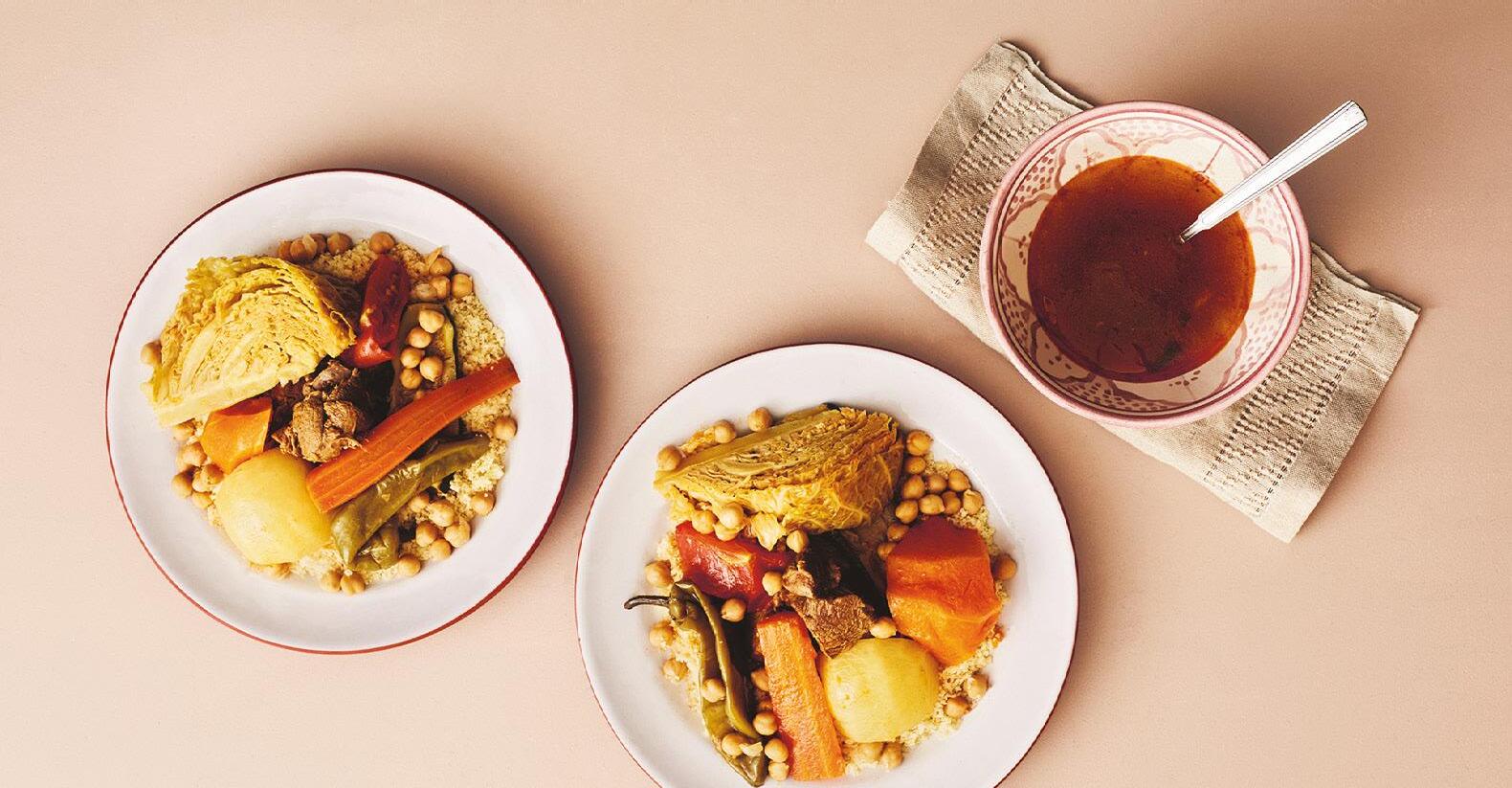
Preparation Time: 30 minutes, plus soaking and resting time
Cooking Time: 1 hour 30 minutes
Serves 6–8
Many in Morocco would call this couscous with seven vegetables the country’s national dish. This is especially true in urban areas, where a wide choice of vegetables is always available, or on the fertile plains in the west that are well known for their agriculture. The choice of vegetables varies throughout the season, from fresh broad (fava) beans and artichokes in spring to fennel in winter and pumpkin or squash in autumn. While the number seven is auspicious throughout Islam, couscous aux sept légumes often has — season allowing — more than seven different types of vegetables (as in this recipe).
If using canned chickpeas (garbanzo beans) rather than dried ones, rinse and add with the pumpkin and courgettes (zucchini).
100g (1/2 cup) dried chickpeas (garbanzo beans)
750g (4 1/2 cups) medium couscous
500g bone-in lamb leg, shoulder or neck, or beef shanks, cut into 6–8 pieces
2 red or yellow onions, quartered
1 tablespoon sweet paprika
Pinch of saffron threads, crumbled
2 tablespoons olive oil, plus extra for preparing the couscous
4 carrots, halved crosswise and lengthwise
2 turnips, peeled and halved lengthwise
4 ripe tomatoes, quartered
12 sprigs flat-leaf parsley
12 sprigs coriander (cilantro)
2 wedges green cabbage (about 250 g/9 oz total)
2 white potatoes, peeled and quartered lengthwise
400g pumpkin or butternut squash, peeled, seeded and cut into 7.5 × 5cm/3 × 2-inch pieces
2 courgettes (zucchini), scrubbed but not peeled, halved lengthwise and then crosswise
2 long sweet green peppers, halved lengthwise and seeded
25g (2 tablespoons) butter, cut into small piece ssalt and pepper
Put the dried chickpeas (garbanzo beans) into a large bowl, pour in abundant water to cover and leave to soak overnight. The next day, drain and rinse.
If steaming the couscous in a couscoussier over the stew, adding ingredients to the stew before and between steamings as needed.
Put the lamb, onions, paprika and saffron into the bottom of a large couscoussier. Season with salt and pepper and add the oil. Swirl to coat, then cook over a medium heat for 5 minutes. Add 1.5 litres (generous 6 cups) of hot water and bring to the boil. Add the chickpeas, carrots, turnips and tomatoes. Fold the parsley and coriander (cilantro) sprigs, tie into a tight bundle with kitchen string and add. Cook for 30 minutes. (If there is no steaming basket on top, loosely cover the pot.) Add the cabbage and cook for 20 minutes. Add the potatoes, squash, courgettes (zucchini) and peppers and cook for a final 30 minutes. Remove and discard the parsley and coriander, then carefully transfer the vegetables and meat to a large platter with a slotted spoon.
To serve, fluff the warm couscous, add the butter and toss the couscous until coated. Either on a large round serving platter or in individual bowls, gently mound the couscous and make a well in the centre. Place the meat in the well surrounded by vegetables. Scatter chickpeas around the edges and ladle over some broth. Serve with the remaining broth in a bowl to add as desired and, if needed, the remaining vegetables on the side.
28 | Hospitality FEATURE // The North African Cookbook







Compare multiple quotes Protect your business instantly Save time and money *Must be a Qantas Business Rewards member. Maximum of 10,000 Qantas Points earned per policy. Available to new BizCover policy purchase only and not available with any other offer. See Terms & Conditions at bizcover.com.au/qbr The information provided is general only and should not be relied upon as advice. BizCover Pty Ltd (ABN 68 127 707 975; AFSL 501769) © 2023 BizCover. BC2517 bizcover.com.au 1300 805 821 SCAN TO COMPARE QUOTES
Say cheese
The humble toastie is a go-to option for small bars thanks to its practicality, nostalgia, and versatile flavour options.


WORDS Amy Northcott
PHOTOGRAPHY Tim Pascoe for Bar Messenger and Steven Woodburn for Lil Sis
30 | Hospitality
FEATURE // Toasties
THE TOASTIE HITS the comfort food trifecta with its crisp slices of bread, melted cheese centre, and overall nostalgic vibe. But while you may think of it as a childhood treat or the ideal late-night snack, the toastie is far from just a meal to indulge in at home.
More venues, in particular small bars, are adding toasties — or jaffles — to the menu. The uptake can be attributed to the ease of preparation, the lack of kitchen equipment (a chopping board and a frypan will do), and of course, the limitless options when it comes to the fillings chefs can experiment with.

Whether it’s a standalone order or an addition to another dish, the toastie is in the midst of a revival. Hospitality speaks to Alexis Georgiou from Lil Sis, Aaron Rothe from Bar Messenger, and Kieran Ferris from Bad Frankie to find out more.
Lil Sis in Sydney’s The Abercrombie has been serving toasties since the venue opened late last year. Head Chef Alexis Georgiou says the decision to add toasties to the menu came about due to convenience as well as the element of familiarity. “We are limited with kitchen space, so it’s an ideal option,” he says. “Guests typically start with sliced meats and cheeses and the toastie works really well once they’ve had a couple of wines.”
The nostalgia that comes with toasties has inspired the range of fillings the chef has decided to run. “We look back and think of the flavours we enjoyed as kids and hope it brings up the same warm memories for our guests,” says Georgiou. Lil Sis toasties include Heinz spaghetti with cheddar (the most popular order); triple cheese; and pastrami on rye with Swiss cheese, pickles, and Russian dressing.
The Lil Sis team uses two different types of bread for the toasties. “The first is a sourdough tin, which is like a classic sliced white with a bit more flavour and it’s better quality,” says Georgiou. “The second is a rye tin, which is the best for the pastrami toastie.”
The bread is buttered on one side and placed in a jaffle maker butter-side down before slices of cheese and fillings are added. “We use good-quality cheddar and Swiss cheese,” says Georgiou. “On our triple-cheese toastie, we also use Taleggio because it has a strong and distinctive taste and complements the Italianinspired menu.” The second piece of bread is then placed on top butter-side up and cooked for about three and a half to five minutes until it has turned golden brown in colour.
Toasties are also a fixture on the menu at Bar Messenger in Sydney. According to Venue Manager Aaron Rothe, toasties fall in line with the bar’s approachable concept. “We wanted our menu to be full of comfort foods and snacks,” he explains. “Easy bites while catching up with friends over an incredible bottle of wine.”
The toasties are one of the more substantial options on the menu, which also lists small share plates, salumi, and a selection of cheeses. “The toasties are more filling than say some olives or taramasalata,” says Rothe. “It’s also our only hot menu item.”
The practicality that comes with making toasties is also a plus for the small venue. “Toasties are great because they are easy to make and require very little equipment,” says Rothe. Being housed in the heritage-listed Transport House building also means a big kitchen was never an option.
“Trying to add a kitchen is so difficult, so toasties allow us to improve our offering and add depth to the menu.”
Lil Sis has a toastie made with Heinz spaghetti
Bar Messenger uses a combination of pecorino, Gruyère, and ricotta in its toasties
Sonoma Bakery supplies brioche to Bar Messenger
Bad Frankie takes inspiration from classic meals for its range of jaffles
August 2023 | 31 FEATURE // Toasties
“We look back and think of the flavours we enjoyed as kids and hope it brings the same warm memories up for our guests.”
– Alexis Georgiou
Bar Messenger has created options with familiar flavour combinations including a classic grilled cheese with Gruyère, ricotta, and pecorino; mortadella with Gruyère and truffle mustard aioli; and Black Forest ham with Gruyère and caramelised onion. “We look at the classics and what works well,” says Rothe. “We like to put our own quirks on them but keep them as comfort food.” Each toastie is served with house-made pickles and roasted garlic aioli on the plate.
Bread-wise, Rothe and his team opt for brioche from Sonoma Bakery. “It is soft and melts in your mouth and has a beautiful richness from the high butter content,” he says. The brioche is hand-sliced before being coated in ricotta on both sides and filled. “We use ricotta, pecorino, and Gruyère in our toasties. We use ricotta as it adds richness and creaminess while the Gruyère and the pecorino add sharpness and umami.” The toasties are then cooked on an eight-slice toaster until golden brown and the cheese is melted.
Over in Melbourne, Bad Frankie is known for its inventive and unique toasties they refer to as jaffles. Bad Frankie’s Kieran Ferris says the jaffle offering came about after the team was looking for something localised to add to the menu. “We found there are limited offerings that are truly Australian, so while many countries have toasties, the jaffle is truly Australian.” Ferris says the versatility of the dish made it the perfect accompaniment to the venue’s wide selection of drinks. “Toasties are an anytime food and they are filling … but not so filling you won’t be able to finish it. I like that they can be shared and that you can have a hot, toasted jaffle within minutes of ordering.”
The Bad Frankie team takes inspiration from main meals rather than sticking with known filling combinations. “We draw on classic meals you would find at home or at the pub,” says Ferris. “[Meals] such as lasagne, snags with caramelised onions, or a vegan butter chicken.” The Bad Frankie offering changes regularly, but the most Australian option has to be the jaffle version of a sausage sandwich which sees sausages teamed with honey caramelised onions, cheddar, tomato, and mustard. There’s also the Golden Katsu Kween with Japanese golden curry mix, and the Gimme Layers which is essentially lasagne in a jaffle.
Ferris says the Shroom jaffle has been a longstanding favourite with patrons, with garlic, red wine, and thyme mushrooms paired with Australian feta and mozzarella. The venue also releases special jaffles as part of the distillery of the month promotion and has a range of dessert-style jaffles, too.
While the Bad Frankie jaffle method is a trade secret, Ferris says chefs should never be shy with the butter. The venue’s jaffles are usually made with plain white bread or glutenfree bread for those with allergies, but sweeter options use brioche. On the cheese front, a combination of mozzarella, cheddar, and dairyfree options are the go-to. “We use mozzarella cheese for its stretch and texture, cheddar where we want the sharpness and flavour it offers other fillings, and a vegan cheddar for our non-dairy patrons,” says Ferris.
Whether you go down the route of creativity or stick with nostalgic classics for fillings, toasties embody a sense of comfort that will see them remain a staple in the everchanging culinary landscape. ■


32 | Hospitality FEATURE // Toasties
“I like that they can be shared and that you can have a hot, toasted jaffle within minutes of ordering.”
– Kieran Ferris

This season's culinary creations, done better with Saputo DELICIOUS MEALS EVERY TIME SCAN HERE SPRING SENSATIONS Contact your local distributor to enquire or email aus.foodservice@saputo.com for further information. RECIPE INSPIRATION • OUR FOODSERVICE RANGE • USAGE RECOMMENDATIONS • PRODUCT INFORMATION TO VIEW OUR FOODSERVICE MAGAZINE FOR : HOR ECA CON NECT Spring '23
MICE
at
THE MELBOURNE INTERNATIONAL Coffee Expo returns to the city this month from 17–19 August at the Melbourne Convention and Exhibition Centre. 2023 marks the 10th year the event has been held, which brings together exhibitors and attendees from across the globe to celebrate all things coffee.

15,000 people visited the expo last year to discover the latest equipment, meet suppliers, discover roasters, network with fellow café owners, and review manufacturing innovations. All the big names in coffee will be there including Boston Bean Coffee Co, Five Senses Coffee, Hario, and Vittoria.
MICE 2023 will see the Richest Barista competition held over three days. Baristas will battle it out over three knock-out rounds, with the first requiring competitors to pour two espressos, two milk beverages, and two alternative milk beverages in just 10 minutes. The second round will see baristas pour six drinks with latte art in 12 minutes including two macchiatos, two traditional lattes, and two free-pour lattes. The final round puts palates to the test with a cup tasting where competitors need to guess the odd one out before the ultimate winner is determined.
The Produce Innovation Awards offers a chance for visitors to discover the latest and greatest, with all products judged by an independent panel of industry leaders and MICE attendees. Awards include coffee preparation equipment, ancillary electrical equipment, coffee accessories, and specialty beverages.
Tickets are now on sale for the event with one, two, and three-day passes available. internationalcoffeeexpo.com/tickets
Trimatt Systems
Melbourne’s Trimatt Systems is excited to showcase its in-house packaging printer the ColourStar AQ at MICE. The advancement benefits coffee roasters and hospitality providers by supplying a solution for short-run sustainable packaging print needs. The versatile machine is designed for valved coffee bags, packing boxes, and café takeaway food/drink packaging, allowing SMEs to control custom branding print and increase profits without outsourcing. Its merits and affordability are immediately apparent to interested parties.

The ColourStar AQ industrial print system delivers fast, easy, and costeffective performance, achieving professional results. With a friction feeder, conveyor, and height-adjustable HP print head, it prints at a remarkable speed of 27 metres per minute on porous, flat surfaces.
For those looking to discuss their operational goals, Trimatt Systems, 2022 APPMA Australian Machinery Manufacturer award recipient, welcomes visitors to booth E06 for demonstrations at the expo.
34 | Hospitality FEATURE // MICE
What you can’t miss
the Melbourne International Coffee Expo.
MICE must-visit list
Franke Coffee Systems introduces BeyondTraditional, a brandnew product category that connects existing technologies with new trends and customer demands to create solutions that go beyond industry standards. Mytico is the first range in Franke’s new product category BeyondTraditional and can turn an ordinary encounter into a unique moment. Impeccable Italian design on the outside combined with Franke’s Swiss quality on the inside unlocks new possibilities for coffee businesses.
The pioneering new coffee line is equipped with advanced technology that produces consistent, barista-grade coffee while enhancing any location with its unique Italian design. Mytico’s ease of use and reduced height provides room for baristas to converse with customers while easily producing the perfect beverage, all without having to sacrifice any part of the wellknown, much-loved barista theatre. It creates an unforgettable coffee moment that keeps customers coming back for more.

BioPak
BioPak produces sustainable alternatives to conventional single-use packaging for the foodservice industry, offering compostable packaging solutions made from rapidly renewable, plant-based raw materials. BioPark is excited to introduce its revolutionary Aqueous paper BioCups, which feature a groundbreaking water-based dispersion coating and are certified home compostable to Australian AS5810 standards.
Unlike traditional coatings, Aqueous uses water-based ink that seamlessly blends into the paper fibers, reducing material usage while maintaining leak-proof and greaseresistant properties. The paper is responsibly sourced and made from certified FSC™ mix paper. Pair with the homecompostable (AS5810) plant fibre lids for a full-home compostable cup solution that will break down in the home compost with other organic materials such as food waste. Visit BioPak at booth D26 to learn more and make the switch to sustainable packaging today.

August 2023 | 35 FEATURE // MICE
Franke
Milklab
Explore Milklab Lane at MICE, inspired by the Melbourne urban coffee culture and the brand’s collaboration with baristas. Reminiscent of the streets of Melbourne, Milklab’s new-look stand incorporates exterior, hole-in-the-wall style cafés and funky coffee carts that encourage guests to explore and discover the laneways of Milklab where they can enjoy a unique and exciting coffee experience that showcases perfect pairings and highlights tasting notes of the Milklab range.
Ordermentum
Ordermentum connects 39,000 Australian hospitality venues with the country’s best suppliers, automates operations, increases cash flow, and provides valuable business insights. With more than $3 billion in processed orders, Ordermentum’s purpose is to create a more sustainable food and beverage industry by helping suppliers and venues trade smarter.
Gone are the days of burnt-out venue owners and managers. With more than 38,000 venues already onboard, Ordermentum allows seamless ordering and payment for a wide range of products from coffee beans and fresh produce to packaging and beverages.


Unlock new opportunities with ease by exploring a vast network of 750-plus quality suppliers. Give your menu a delightful twist with exciting new products that might become your next bestseller. Manage invoices effortlessly, track order history, set standing orders, and enjoy seamless deliveries.
If you’re attending the Melbourne Coffee Expo, be sure to visit Ordermentum's booth. Experience firsthand how the game-changing platform can streamline your operations, boost efficiency, and unleash your true potential. Don’t miss out on the opportunity to join the growing community that has zero appetite for admin.
Monin
Monin welcomes a new era of ‘espresso smackdown’ with yet another Signature Serve competition final. The serves showcased on the night will adhere to all five senses: taste, aroma, texture, sight, and sound. Judges are at the mercy of their sensory experiences when crowning a winner. Slayer Machines, Melbourne, will host the five national finalists in their battle to prove themselves the 2023 champ and go on to compete in the Asia–Pacific final in Kuala Lumpur, Malaysia.
Along with flights and experiences in Malaysia, the winner will also receive $5,000 cash and the coveted Monin Cup trophy. Make sure you RSVP for a free night of flowing food, espresso martinis, great soundtracks and good times.

36 | Hospitality FEATURE // MICE
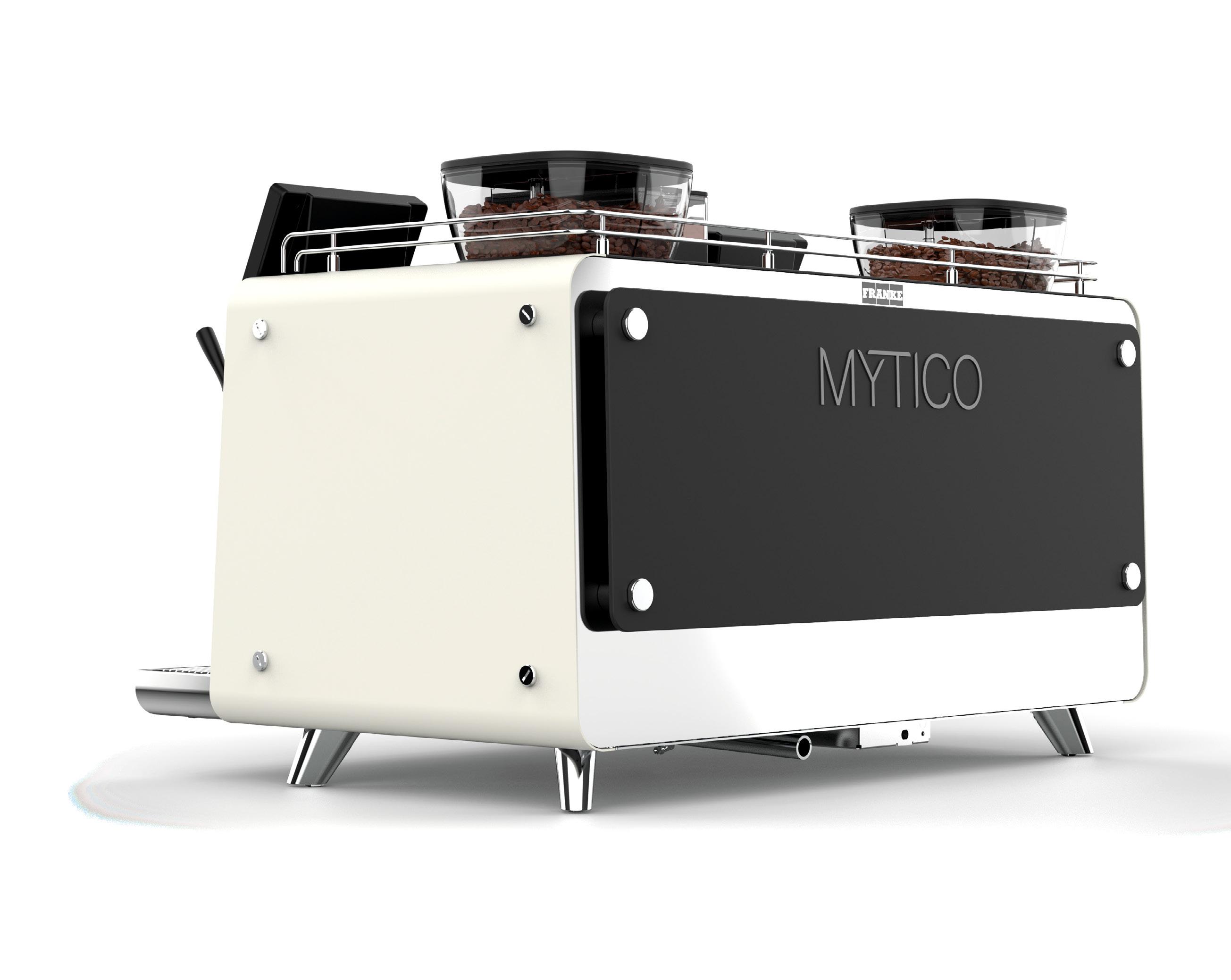
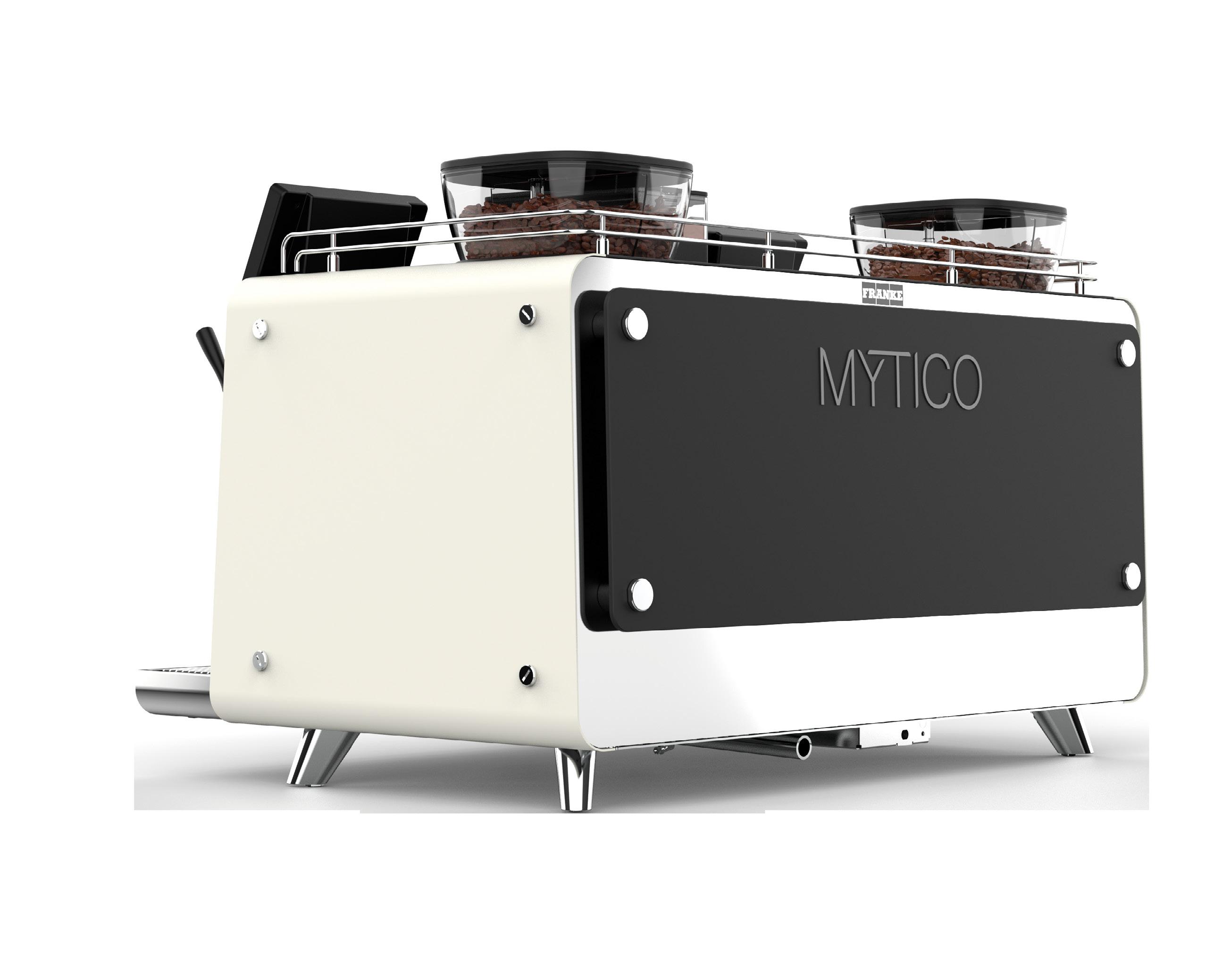

Farm to table
Sustainable and ethical practices are translating to better results on the plate.
WORDS Amy Northcott
PHOTOGRAPHY Hikari Studios, Glue Studio, and Clint Peloso for Salt Kitchen Charcuterie
THERE’S NO DOUBT sustainability is an important topic in the hospitality sector. Here in Australia, the pork industry is leading the way when it comes to more ethical and environmentally conscious protein production. Chefs and operators are increasingly sourcing sustainable and ethical pork for many reasons from meeting customer expectations to cooking with a superior-quality meat with an unrivalled flavour profile.
To find out more about how sourcing sustainable and ethical pork translates to the plate, Hospitality speaks to Western Plains Pork CEO Judy Croagh, Chef and Restaurateur Adrian Richardson, and Salt Kitchen Charcuterie’s Mick Nunn.
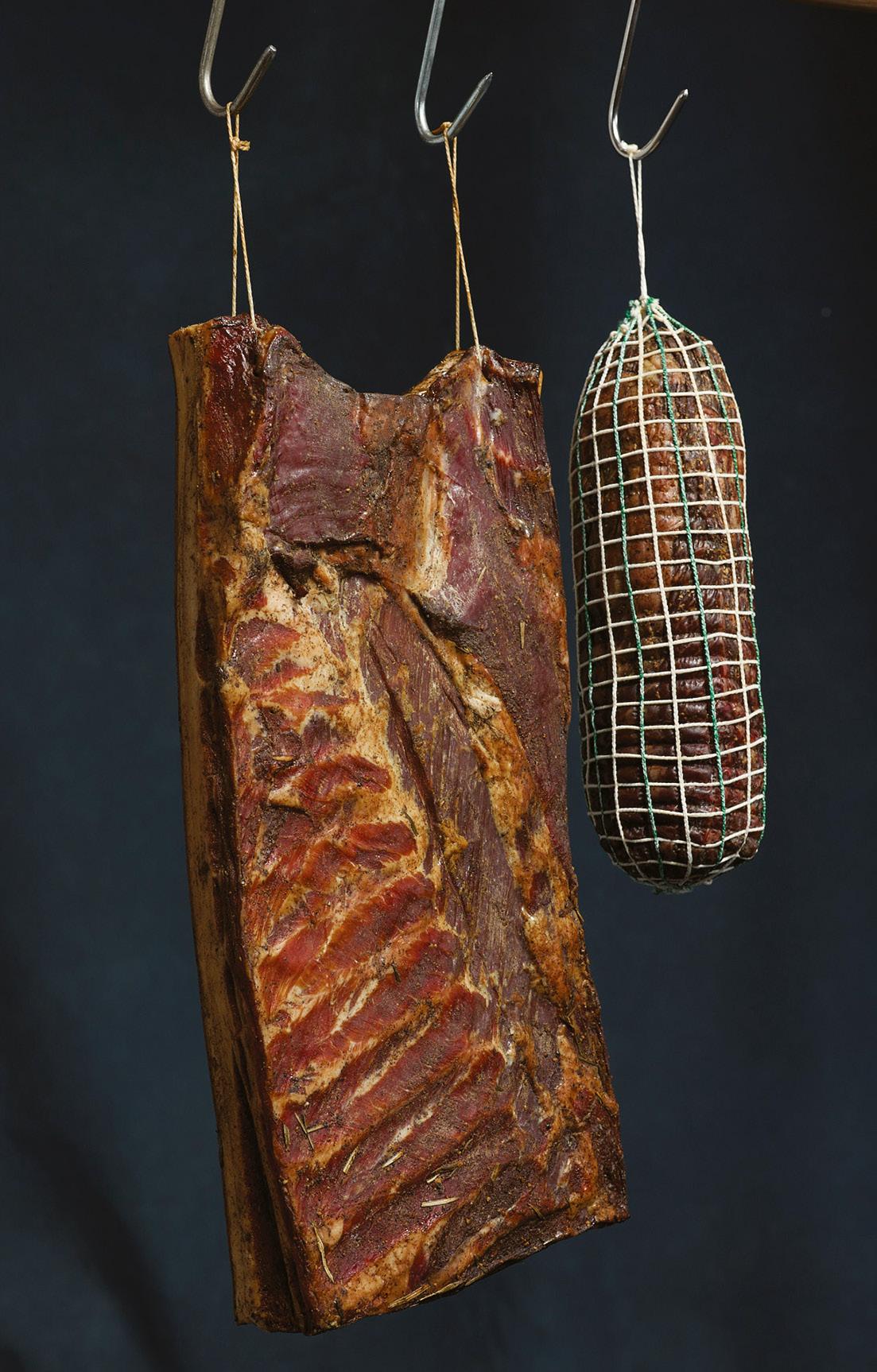
Sustainable and ethical pork production has always been at the core of Western Plains Pork in Victoria’s Mount Mercer. “We are doing the same thing we’ve always done, and we continually


38 | Hospitality
FEATURE // Sustainable pork
try to improve everything we do,” says Judy Croagh. Western Plains Pork implements an array of practices across its farm such as moving pigs to different sites every three years to help minimise the impact on the grounds as well as prevent pollution from the animals. Pig waste is used for compost, solar panels for energy, and the use of artificial growth agents or stimulants is avoided. Western Plains Pork also places great importance on animal welfare and have an outdoor-bred environment. Strict training is provided to staff to ensure all pigs are treated well. “It’s always about our people, our pigs, and the environment within our business,” says Croagh. “Animal husbandry is everything … through the whole system, animal welfare is a priority.”
The farm’s unwavering commitment to animal welfare and consideration of the environment has caught the attention of many who are in pursuit of a greener approach to their work.
Chef Adrian Richardson from Melbourne’s La Luna Bistro and Bouvier Bar & Grill has been using Western Plains Pork for more than 20 years. “If people are prepared to pay a little bit more for a better-quality and more sustainable product now, the world will eventually become a better place,” he says.


Alongside the obvious environmental benefits, the chef believes it’s an essential requirement for venues to source sustainably and ethically when it comes to the proteins chefs cook with. “Consumers expect chefs to do their due diligence and make sure what they are serving is of the best quality,” says Richardson. “They are more aware of what they’re eating and there’s a lot of publicity about sustainability and the ethical treatment of animals.” Richardson admits he doesn’t place importance on marketing his sustainable and ethical pork sourcing as he knows it’s an expectation. However, he does spend time educating staff on pork sourcing in case they are asked. “It’s not something I get out there and wave a flag around about,” he says. “So they [consumers] might not ask, but I do know they expect it.”
Richardson purchases whole pigs from Western Plains Pork which he uses to produce a range of smallgoods such as salami, capicola, lardo, pancetta, and prosciutto. “We use the entire animal to make products that we then sell for the rest of the year,” he says. “So, we’re self-sustainable when it comes to all our smallgoods.” Richardson also makes sausages, pork rillette, and
August 2023 | 39 FEATURE // Sustainable pork
“Sustainable production and healthy pigs translate to a quality and consistency that is easily recognisable to a producer of salumi and charcuterie.”
– Mick Nunn
Pork moves pigs every three years to avoid ground impact
Well-grown, stress-free pigs produce better-quality pork
terrines. “It’s an extremely versatile protein to use,” he says. “You can make so many different products out of it either fresh or cured.”
Quality is an added bonus of working with ethical proteins, and is attributed to a range of factors including the way the animals are treated during their lifespan, their environments, and not being exposed to stressful experiences before they are slaughtered. “If an animal has lived a good life roaming the fields, they’re happy and grow properly, so they get the right amount of fat in them,” says Richardson. “The less stress the animal has, the better quality the meat is.”
Consumers are asking more questions about where meat comes from
Salt Kitchen Charcuterie does a nose-to-tail breakdown of pigs
Dark cuts from altered pH levels may be found on a protein and are a sign an animal hasn’t been treated well. “It [dark cuts] makes them really terrible to eat,” says Richardson. The chef has also found sustainable and ethical pork products to be firmer, have marbling, and be more consistent in size and flavour.

Mick Nunn from Delacombe’s Salt Kitchen Charcuterie in Victoria also uses Western Plains Pork to make his handmade range of smallgoods. The majority of his clients work in the industry and ask questions about the proteins used to make the products. “I think chefs and restaurateurs are sourcing more information than they ever have on where products are being produced and how sustainable they are,”
he says. Nunn says the interest has carried on to consumers, too. “There’s been an uptick because people want to know and understand provenance. Consumers, particularly post-Covid, are even more discerning about the production and sustainability of proteins.”
Western Plains Pork has a dedicated paddock for Salt Kitchen Charcuterie and grows larger pigs that are double the size of the others. Nunn uses each part of the pig, and says the meat determines Salt Kitchen’s product list. Scotch or neck muscle is used to make capocollo, with belly used to make streaky bacon and pancetta. Nunn also uses pork in dry-cured products including a Noix de jambon (French single-muscle ham), dry-cured ham, and fiocco which is made from a small muscle in the back leg. Trims are utilised in products such as mortadella, salami, fresh sausages, mince, pâtés, and terrines.
Like Richardson, Nunn agrees sustainable and ethical practices implemented at farms have a big impact on the final product. “Sustainable production and healthy pigs translate to a quality and a consistency that is easily recognisable to a producer of salumi and charcuterie,” he says. “Certainly [the animals] being free-range is beneficial to the end product from a flavour, muscle structure, and fat content standpoint.”
40 | Hospitality FEATURE // Sustainable pork
Western Plains
Walking together, working together. Although from very different backgrounds, these industry luminaries share many wonderful traits: talent, passion, respect and a great love for that no-waste, forever-giving, magical beast known as - The Pig. Masters of their crafts, they know full well, the endless delicious possibilities it provides. They are PorkStars. porkstar.com.au
 Pictured (L-R): Adrian Richardson - Chef, Judy Croagh - Farmer, Ross Magnaye - Chef, Mick Nunn - Charcutier, Annie Smithers - Chef.
Pictured (L-R): Adrian Richardson - Chef, Judy Croagh - Farmer, Ross Magnaye - Chef, Mick Nunn - Charcutier, Annie Smithers - Chef.
Consciously sourcing sustainable proteins is something to be proud of, and Nunn promotes Western Plains Pork on product labels and marketing activity. “The quality and consistency of our raw product can be attributed to the practices used at the farm,” says Nunn. “It’s always been important for Salt Kitchen Charcuterie to align ourselves with producers that can produce proteins that deliver on flavour.”

There’s no doubt sustainable proteins are the way of the future. “Sourcing products with a sustainable focus flows to the customer and creates a really good environment for the future,” says Croagh. “If the consumer is asking questions and the chefs are, too, it’s really positive.”

Richardson agrees and believes there is already a wider range of ethical and sustainable pork options on the market now. “Whether you want small, large, or even free-range organic producers — they’re all there,” he says. “You just have to Google or pick up the phone and you’ll be able to track them down.”
Connecting with farms directly to understand what they offer as well as to learn more about their farming practices is also a must. “Speak to the farm as much as you can,” says Nunn. “If you can get in contact with the source, it’s only going to be beneficial to be able to understand where your product is coming from.” Richardson hopes increased education will make sustainable and ethical pork production the norm. “The more we purchase these products, the more we reward the people who are doing the right thing.” ■
42 | Hospitality FEATURE // Sustainable pork
“Consumers expect chefs to do their due diligence and make sure what they are serving is the best quality.”
– Adrian Richardson



MILKYBAR ® and AERO ® are registered trademarks of Société des Produits Nestlé S.A., Vevey, Switzerland. Third Party Foodservice Operators must not use MILKYBAR ® and AERO ® logos without authorisation from Nestlé Australia Ltd. Serving suggestion Visit www.nestleprofessional.com.au/news/branded-desserts to find out more or contact your local Nestlé Professional Sales Representative on 1800 20 30 50 They’ll be lining up, for our iconic brands
Gastronorm tray
The standardised container has been an essential since its launch in the ’60s.
Made from premium-grade polycarbonate

Raised edge allows product to neatly fit into storage spaces
1.05-litre capacity
Temperature range is -40–100-degrees Celsius
Optional lid sold separately
Designed to drip dry
SCAN HERE TO BUY

Dishwasher-safe
Polycarbonate material remains cool to touch
Essential for mise en place and efficient service
44 | Hospitality EQUIPMENT // Gastronorm tray
Adande’s patented refrigerated drawers are unique to the marketplace, ensuring that the cold air is retained when a drawer is opened which makes it one of the most energy e cient units on the market.
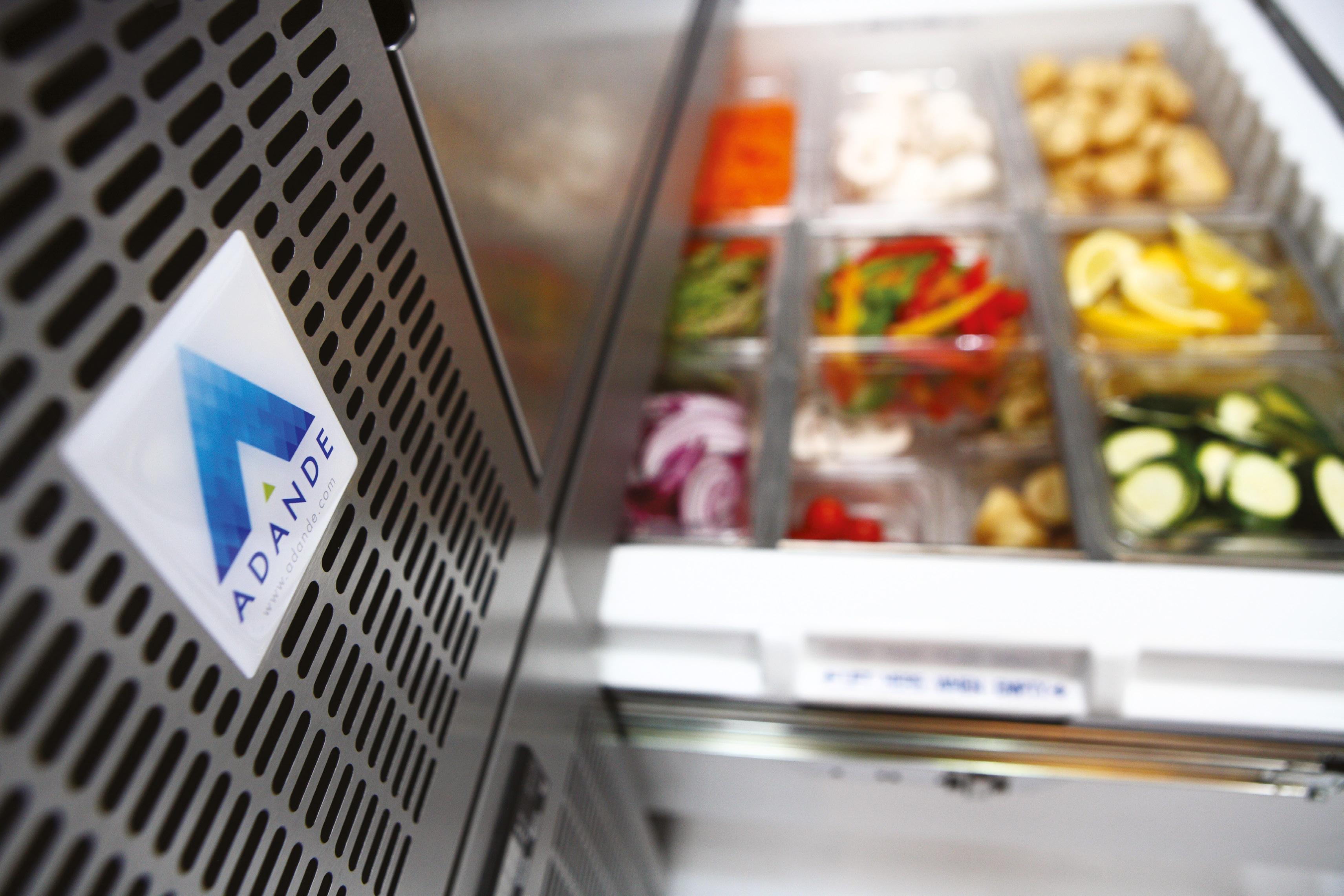
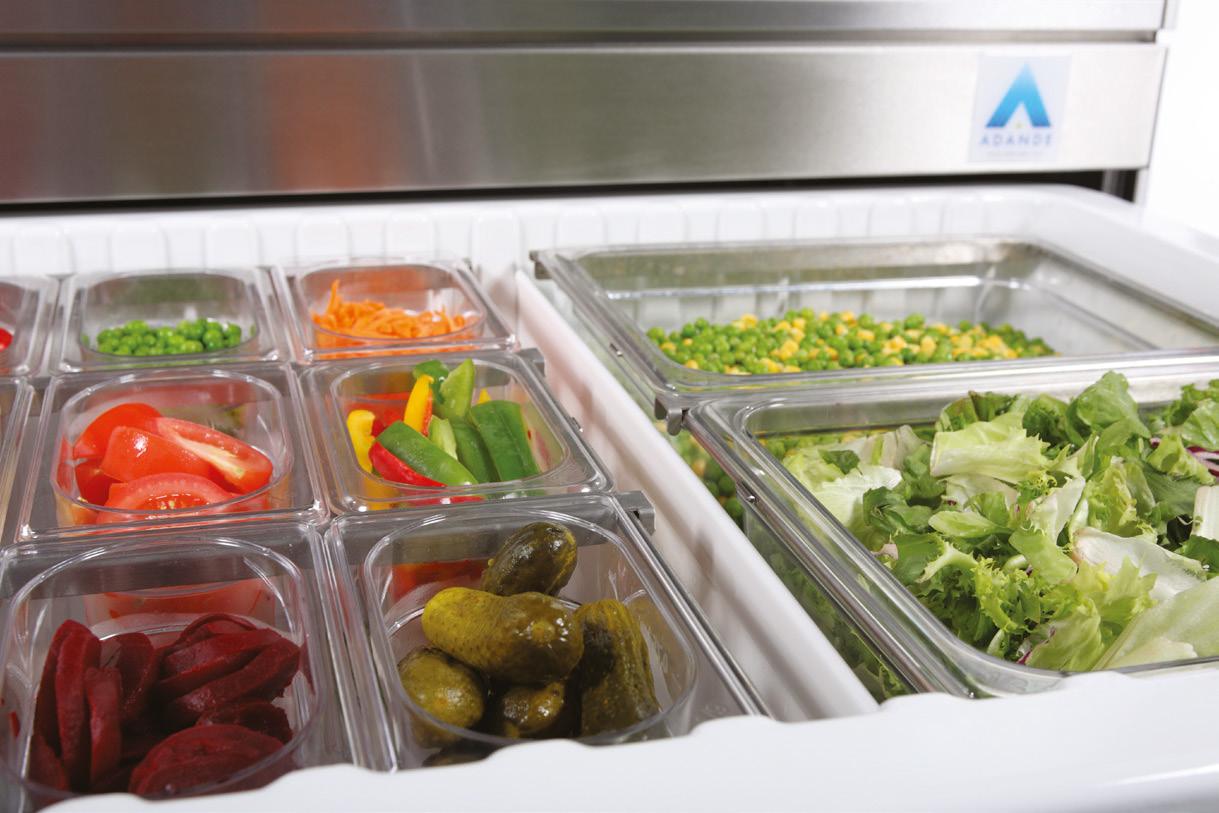
15˚C – -22˚C adjustable temperature, in 1˚C increments, allowing you to store your product at its optimum temperature, extending product life.

+15°C -22°C 2 5
Adande Drawer System provides you with incredible flexibility in the kitchen. With a range of di erent base and top options to create di erent working heights, weight loadings, and manoeuvrability. There are also a range of accessories to help organise product within the drawer.

*Conditions Apply

I GREW UP on a vineyard in Victoria, so learning about the process, the importance of fresh produce, and how food and wine are intertwined happened naturally. I was always eating fresh seafood at the Lakes Entrance, fishing with my mates in tinnies after school, and I worked in the kitchen at my sister’s restaurant, so I’ve always been around food and restaurants. It was an easy path for me to take.
Growing up around restaurants and produce helped, but I learned the most when I was running multi-site kitchens with different cuisine offerings. Opening my own business Sodafish in the Lakes Entrance has also given me an overall view of a hospitality operation, so it set me up to really understand every aspect. Expanding into the hotel space was the logical next step and having a solid understanding of restaurants and operations at every phase of growth.
After operating restaurants across Australia, the role with Public was the right next step in my career. I get to work with our chefs, menus, and behind the scenes to make sure all our venues run

Nick Mahlook

smoothly. We also have one of the most unique portfolios in the industry, with classic pub menus at Lady Hampshire to Italian trattoria menus at Camelia Grove — I need to change tact quickly, which is fun and challenging.
There are 13 venues currently open, with a stack more to come in 2023 and 2024. I work across every venue in the group to some degree — collaborating and consulting with the culinary team including our Creative Culinary Director Clayton Wells and The Maybe Group directors Vince [Lombardi], Stefano [Catino], and Martin [Hudak] to ensure there’s synergy across our food and beverage menus. Despite their differences, all feature quality produce and techniques.
Each venue demands different tactics to make a diner’s experience equally as unique, as does each chef when it comes to mentorship. I liked the idea of mentoring some of the younger culinary talents and collaborating to make sure we’re adequately rostering, purchasing quality produce, and perfecting the basics.
We want all our venues to feel unique as we’ve created spaces from something a neighbourhood has either once loved or missed. Some of our newest venues are already vital in their areas including Sydney venues Oxford House in Paddington, Lady Hampshire in Camperdown, and The Strand Hotel in Darlinghurst.
We’re such a new and agile team, so we grow together, every day and it makes me proud. We’ve learned so much. As we open venues, we learn from one another and become part of different neighbourhoods, so we naturally work more cohesively.
We have a slew of upcoming openings including developing our new hotel and food and beverage concepts at the Noah’s Backpackers site in South Bondi. We’re also continuing to focus on uplifting our open venues to ensure they continue to be of the quality our guests and locals have come to know. We’re working with some exciting culinary talents to help us bring new venues to life in the second half of this year and into 2024, so we’re looking forward to opening and revealing them. ■
46 | Hospitality 5 MINUTES WITH ... // Nick
Mahlook
Public’s group culinary director on growing up in restaurants and working across 13 (and counting) venues.
Hostplus is a top-performing super fund that puts members first. That’s why we’re proud to have been named the 2023 Fund of the Year by third-party ratings agency SuperRatings. Judged across three areas: strong performance, competitive fees, and an ongoing focus on members, we’re thrilled to receive this recognition.






www.hostplus.com.au
The rating is issued by SuperRatings Pty Ltd ABN 95 100 192 283 AFSL 311880 (SuperRatings). Ratings are general advice only and have been prepared without taking account of your objectives, financial situation or needs. Consider your personal circumstances, read the product disclosure statement and seek independent financial advice before investing. The rating and awards are not recommendation to purchase, sell or hold any product and are only one factor to be taken into account when choosing a super fund. Past performance information is not indicative of future performance. Ratings are subject to change without notice and SuperRatings assumes no obligation to update. SuperRatings uses objective criteria and receives a fee for publishing awards. Visit www.lonsec.com.au/superfund/ratings-and-awards/ for ratings information and to access the full report. © 2022 SuperRatings. All rights reserved. General advice only. Consider the relevant Hostplus PDS and TMD at hostplus.com.au and your objectives, financial situation and needs, which have not been accounted for. Awards and ratings are only one factor to consider. Host-Plus Pty Limited ABN 79 008 634 704, AFSL 244392 trustee for Hostplus Superannuation Fund, ABN 68 657 495 890. HP2392









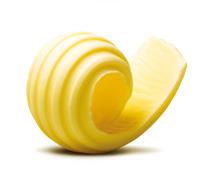
To order La Parisienne contact your local distributor. For further information or technical support contact Peerless Foodservice on 1800 986 499 or visit: peerlessfoodservice.com.au / peerlessfoodservice Making it happen VISIT US:
















 WE’RE IN THE final month of winter, and I have to admit, I am one of the few people who will miss it. The cool season has seen a stellar line up of launches from Longshore in Sydney (the subject of our profile) to the opening of Odd Culture’s first location in Melbourne. There’s much to look forward to as we move into spring with new steakhouse concept Alfie’s from Liquid & Larder arriving in the Harbour City soon, which is promising a steak on the table within 15 minutes of ordering. All in all, things are looking good. This issue, we delve into the world of North African cuisine, spend five minutes with
WE’RE IN THE final month of winter, and I have to admit, I am one of the few people who will miss it. The cool season has seen a stellar line up of launches from Longshore in Sydney (the subject of our profile) to the opening of Odd Culture’s first location in Melbourne. There’s much to look forward to as we move into spring with new steakhouse concept Alfie’s from Liquid & Larder arriving in the Harbour City soon, which is promising a steak on the table within 15 minutes of ordering. All in all, things are looking good. This issue, we delve into the world of North African cuisine, spend five minutes with
























 By Erchen Chang, Shing Tat Chung, and Wai Ting Chung Phaidon ; $59.95
By Erchen Chang, Shing Tat Chung, and Wai Ting Chung Phaidon ; $59.95




 Photography by Jiwon Kim
Photography by Jiwon Kim





 EDITED BY Annabelle Cloros
EDITED BY Annabelle Cloros

























































 Pictured (L-R): Adrian Richardson - Chef, Judy Croagh - Farmer, Ross Magnaye - Chef, Mick Nunn - Charcutier, Annie Smithers - Chef.
Pictured (L-R): Adrian Richardson - Chef, Judy Croagh - Farmer, Ross Magnaye - Chef, Mick Nunn - Charcutier, Annie Smithers - Chef.

































